Paul van Yperen's Blog, page 268
June 19, 2018
Curd Jürgens
Tall, blonde, blue-eyed Curd Jürgens (1915-1982) played German soldiers in countless World War II films, usually billed as Curt Jurgens. Although the German-Austrian actor appeared in over 100 films, Jürgens considered himself primarily a stage actor. He also directed a few films, with limited success, and wrote screenplays.
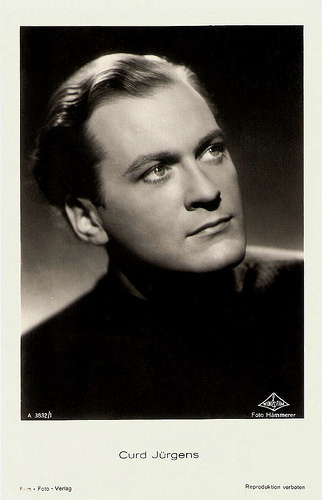
German postcard by Film-Foto-Verlag, no. A 3832/1, 1941-1944. Photo: Hämmerer / Wien Film.
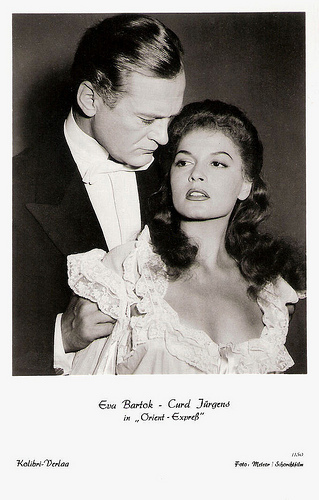
German postcard by Kolibri-Verlag, no. 1180. Photo: Meteor / Schorchtfilm. Still from Orient Express (Carlo Ludovico Bragaglia, 1954) with Eva Bartok .
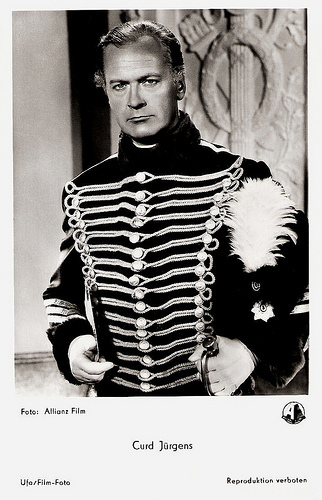
German postcard by Ufa, Berlin-Tempelhof, no. FK 3413. Photo: Allianz Film. Publicity still for Michel Strogoff/Michael Strogoff (Carmine Gallone, 1956).
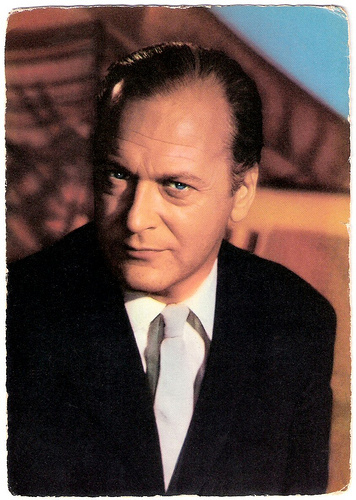
German postcard by ISV, no. C 1. Photo: Divina / Gloria / Grimm.
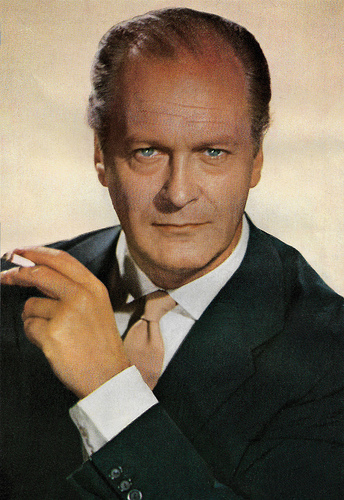
Vintage card.
Strikingly Handsome Young Man
Curd Gustav Andreas Gottlieb Franz Jürgens was born in Solln near München (Munich), Germany in 1915. His father was a trader from Hamburg and his mother a French teacher.
Since he wanted to become a writer, the eighteen-year-old Jürgens took a job as a reporter for the newspaper Acht-Uhr Abendblatt in Berlin. He married actress Lulu Basler after conducting an interview with her. She and her mother, Maria Solani, a former silent film star, encouraged the strikingly handsome young man to become a film actor.
His aristocratic bearing, his tall, stately appearance, and his talent for languages formed the foundation of his career. He learned his new profession on the Vienna stage, which retained his loyalty even after he became a global film star. He would become an ensemble member at the famous Vienna Burgtheater from 1940 to 1953 and from 1965 to 1968.
In 1933, he had a severe car accident. The medics had to cut his spermatic cords, which resulted in a life-long infertility. His only child was, as later revealed by her mother, Eva Bartok, not his own.
When he applied for a job at the UFA Studio in Neu-Babelsberg, he was discovered by Willi Forst , who hired him for the role of the young emperor Franz Joseph in Königswalzer/The King's Waltz (Herbert Maisch, 1935). The next year Jürgens starred in Familienparade/Family Parade (Fritz Wendhausen, 1936).
In 1937, he was cast opposite Swedish star Zarah Leander in Zu neuen Ufern/To New Shores (Detlev Sierck a.k.a. Douglas Sirk, 1937). The following years he appeared in films like Salonwagen E 417/Private Car E 417 (Paul Verhoeven, 1939) with Paul Hörbiger and Käthe von Nagy , Operette/Operetta (Willi Forst, 1940), Wen die Götter lieben/Whom the Gods Love (Karl Hartl, 1942) again as Emperor Josef II; and Frauen sind keine Engel/Women Are No Angels (Willi Forst, 1943) with Marte Harell .
Gradually increased his career status, but in 1944 minister Joseph Goebbels sent him to a concentration camp for ‘political unreliables’, due to his anti-Nazi opinions. It was this experience in Nazi Germany that led him to become an Austrian citizen in 1945.
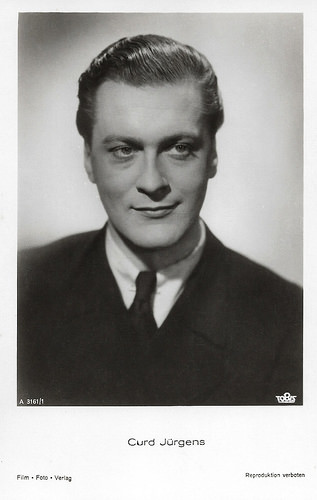
German postcard by Film-Foto-Verlag, no. A 3161/1, 1941-1944. Photo: Tobis.
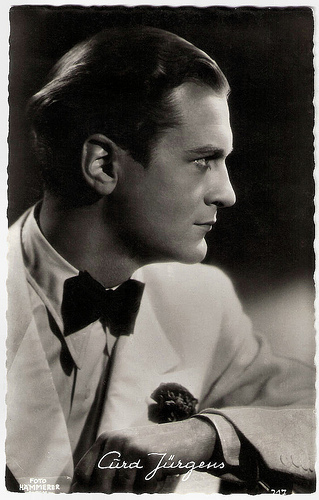
Austrian postcard by Verlag Hubmann, Wien (Vienna), no. 3323. Photo: Hämmerer, Wien.
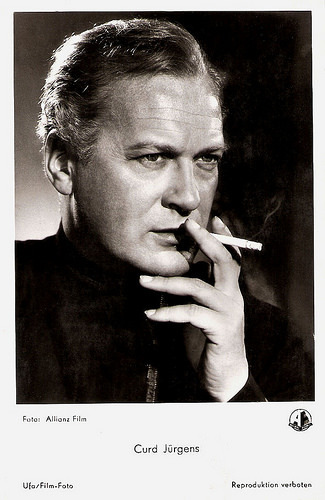
German postcard by Ufa/Film-Foto, Berlin-Tempelhof, no. FK 3412. Photo: Allianz Film.
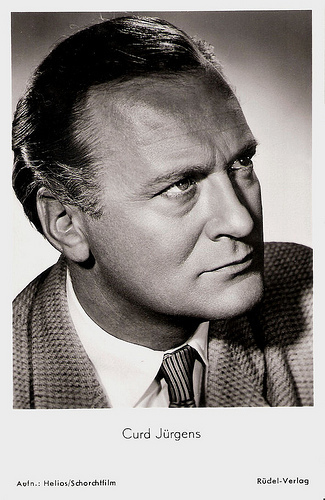
German postcard by Rüdel Verlag, Hamburg-Bergedorf, no. 567. Photo: Helies / Schorchfilm. Publicity still for Musik bei Nacht/Music by Night (Kurt Hoffmann, 1952).
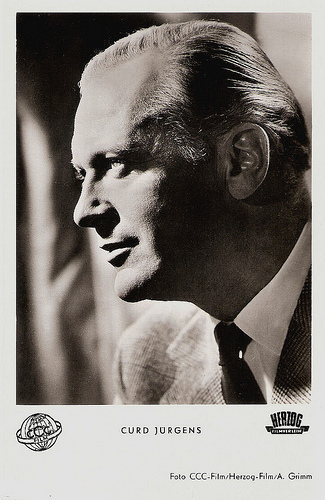
German postcard by Kunst und Bild, Berlin, no. I 409. Photo: CCC-Film / Herzog-Film / A. Grimm. Publicity still for Die Ratten/The Rats (Robert Siodmak, 1955).
The Norman Hulk
After the war, Curd Jürgens continued to appear in German and Austrian films. His films included Das singende Haus/The Singing House (Franz Antel, 1948) with Hannelore Schroth , Der Engel mit der Posaune/The Angel with the Trumpet (Karl Hartl, 1948) with Paula Wessely , Hexen/Witches (Hans Schott-Schöbinger, 1949), Wiener Mädeln/Viennese Girls (Willi Forst, 1949), and Das Bekenntnis der Ina Kahr/The Confession of Ina Kahr (Georg Wilhelm Pabst, 1954) with Elisabeth Müller .
Jürgens co-authored with his friend Kurt Heuser the screenplay Prämien auf den Tod/Premium on Death (1950) and he also directed the film. Jürgens wrote, directed, and starred in a second film as well, Gangsterpremiere (1951).
The now cosmopolitan Jürgens exchanged Berlin and Vienna for the in-places of the beautiful and rich in St. Tropez, London, and Rome. His wealth, fame, love affairs, and parties made more headlines in the illustrated and scandal magazines than his films.
His breakthrough screen role came in 1955 with Des Teufels General/The Devil's General (Helmut Käutner, 1955), based on Carl Zuckmayer's play. Jürgens played the honorable pilot General Harras, who sells his soul to the devil because of his love for flying. That same year he won the Volpi Cup for Best Actor at the Venice Film Festival for Les Héros sont Fatigués/The Heroes Are Tired (Yves Ciampi, 1955).
Then he appeared in the sensational French film Et Dieu... créa la femme/And God Created Woman (Roger Vadim, 1956) as Brigitte Bardot 's older lover. BB nicknamed him ‘The Norman Hulk’.
Always interested in multilingual European actors with good looks and talent, Hollywood beckoned him. In 1957, he appeared in his first Hollywood film, The Enemy Below (Dick Powell, 1957), as a WW II U-boat commander in a duel with an American destroyer commander Robert Mitchum .
Jürgens was subsequently the star of a well-intended but ill-fated remake of Der blaue Engel, The Blue Angel (Edward Dmytryk, 1959), taking on the role of the doomed teacher identified with Emil Jannings . He fared rather better playing rocket scientist Werner Von Braun in the biographical film Wernher von Braun/I Aim at the Stars (J. Lee Thompson, 1959).
He went on to be a leading star of the European stage and international films. Onscreen he often played urbane villains including Cornelius, the cowardly and treacherous trading company representative, in Lord Jim (Richard Brooks, 1965), and sometimes a Nazi. A notable performance in this vein is the meditative officer in the epic The Longest Day (Ken Annakin, Andrew Marton, Bernhard Wicki, 1962), the most expensive black-and-white film ever made.
One of his most famous roles was as the James Bond villain Karl Stromberg in The Spy Who Loved Me (Lewis Gilbert, 1977), arguably the best entry in Roger Moore 's Bond series. Stromberg was a sociopathic industrialist seeking to transform the world into an ocean paradise.
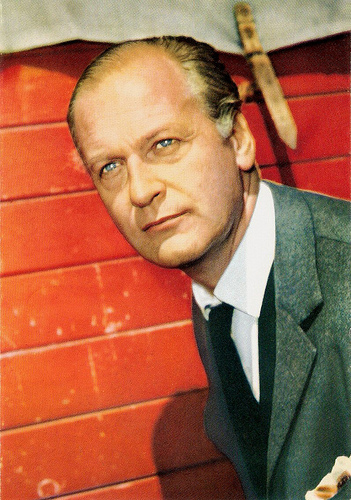
American postcard by East-West Publishers.
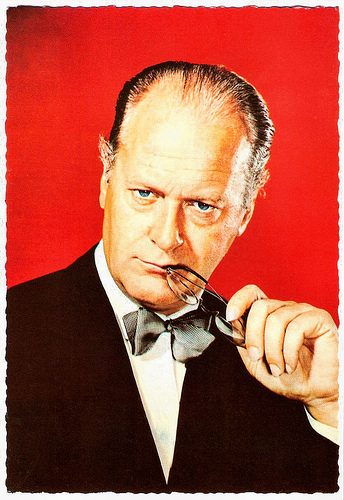
French postcard by E.D.U.G., no. 95.
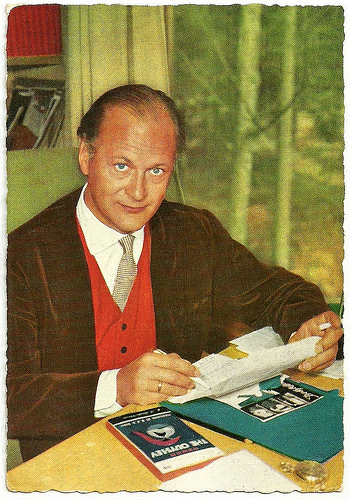
German postcard by WS Druck, Wanne-Eickel, no. F 9. Photo: Ringpress.
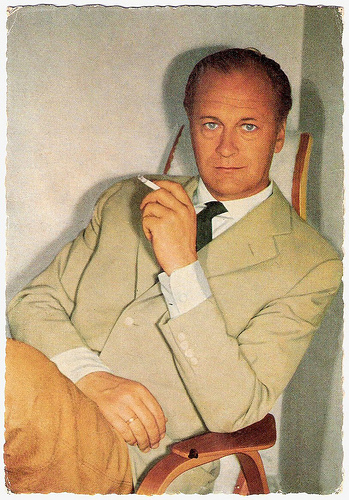
German postcard by WS-Druck, Wanne-Eickel, no. F 36. Photo: Ringpress.
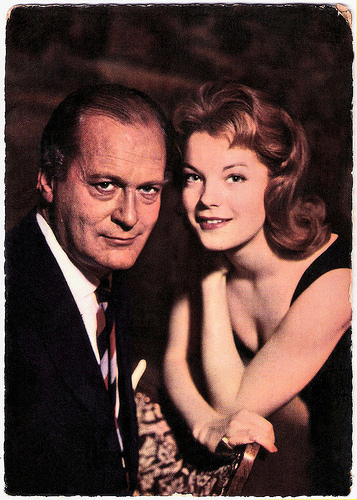
German postcard by ISV, no. 4. Photo: publicity still for Katia/Adorable Sinner (Robert Siodmak, 1959).
Near-death Experience
Showing his sense of humour, Curd Jürgens titled his autobiography, ...und kein bißchen weise/Sixty and Not Yet Wise (1976). He made his last stage appearance as Pasha Selim in The Abduction from Seraglio during the Vienna State Opera's tour in Japan (1980).
His last film appearance was as Maître Legraine, beside Alain Delon and Claude Jade in the Soviet spy-thriller Tegeran 43/The Eliminator (Aleksandr Alov, Vladimir Naumov, 1981). His last TV role was as General Vladimir in the BBC miniseries Smiley's People (1982) based on the novel by John Le Carré and starring Alec Guinness .
In his wide and diverse acting career, Jürgens was nominated for two BAFTA's and was gifted the German Film Prize Filmband in Gold in 1959 and the Bundesverdienstkreuz (Cross of Merit of Germany) in 1981 for his outstanding contributions to the German cinema.
Curd Jürgens maintained a home in France, but frequently returned to Vienna to perform on stage and that was where he died of a heart attack in 1982. He was 66 years old. He had been hospitalised for the last two months. Friends said he had refused to reduce his activities despite years. Jürgens had suffered another heart attack several years before. During this he had a near-death experience where he claimed he died and went to Hell.
Curd Jürgens was married five times: to actress Louise ‘Lulu’ Basler (1937-1947), Austrian actress Judith Holzmeister (1947-1955), actress Eva Bartok (1955-1957), Simone Bicheron(1958-1977), and Margie Schmitz (from 1978 till his death in 1982). He had one daughter, Deana, with Eva Bartok , but she was fathered by Frank Sinatra.
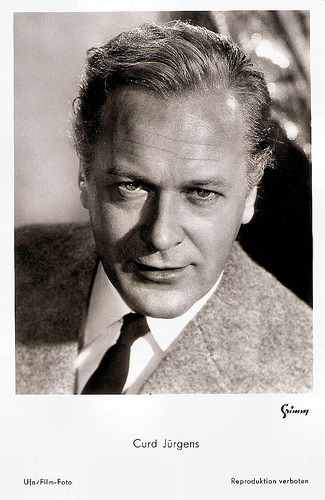
German postcard by Ufa/Film-Foto, Berlin-Tempelhof, no. FK 3916. Photo: Arthur Grimm.
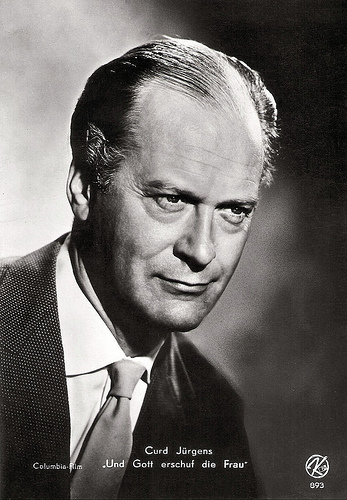
Austrian postcard by Kellner-Fotokarten, Wien (Vienna), no. 893. Photo: Columbia-Film. Publicity still for Et Dieu... créa la femme/...And God Created Woman (Roger Vadim, 1956).
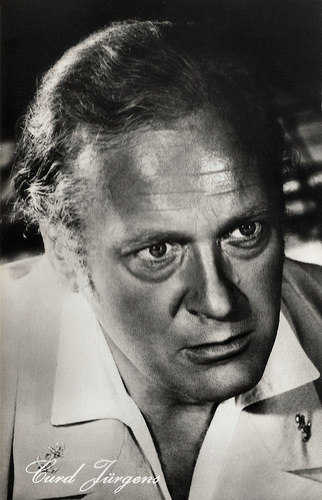
East-German postcard by VEB Progress Film-Vertrieb, Berlin no. 1339, 1960. Photo: publicity still for Tamango (John Berry, 1958).
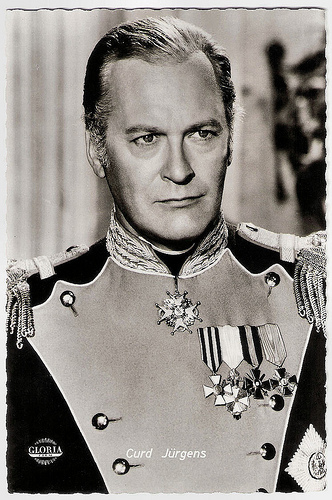
German postcard by Kolibri-Verlag G.m.b.H., Minden/Westf., no. 996. Photo: Speva / Gloria-Film. Publicity still for Katia/Adorable Sinner (Robert Siodmak, 1959).
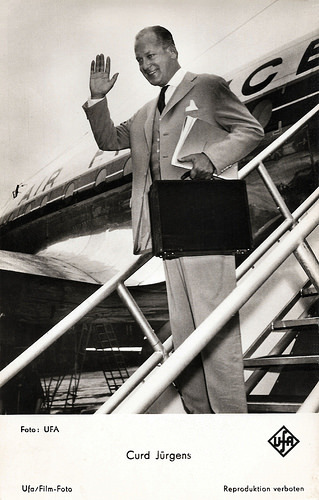
German postcard by Ufa/Film-Foto, Berlin-Tempelhof, no. FK 4619. Photo: Ufa.
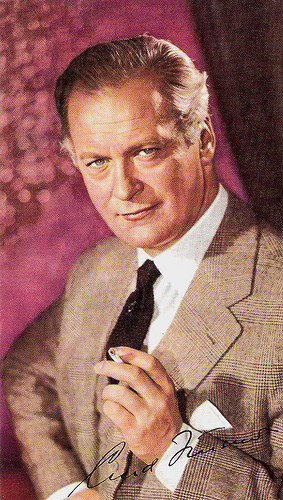
German collectors card by Lux.
Trailer for The Spy Who Loved Me (1977). Source: Movieclips Trailer Vault (YouTube).
Sources: Gertraud Steiner Daviau (Film Reference), T. Johnson (Find A Grave), (IMDb), AllMovie, Wikipedia, and .

German postcard by Film-Foto-Verlag, no. A 3832/1, 1941-1944. Photo: Hämmerer / Wien Film.

German postcard by Kolibri-Verlag, no. 1180. Photo: Meteor / Schorchtfilm. Still from Orient Express (Carlo Ludovico Bragaglia, 1954) with Eva Bartok .

German postcard by Ufa, Berlin-Tempelhof, no. FK 3413. Photo: Allianz Film. Publicity still for Michel Strogoff/Michael Strogoff (Carmine Gallone, 1956).

German postcard by ISV, no. C 1. Photo: Divina / Gloria / Grimm.

Vintage card.
Strikingly Handsome Young Man
Curd Gustav Andreas Gottlieb Franz Jürgens was born in Solln near München (Munich), Germany in 1915. His father was a trader from Hamburg and his mother a French teacher.
Since he wanted to become a writer, the eighteen-year-old Jürgens took a job as a reporter for the newspaper Acht-Uhr Abendblatt in Berlin. He married actress Lulu Basler after conducting an interview with her. She and her mother, Maria Solani, a former silent film star, encouraged the strikingly handsome young man to become a film actor.
His aristocratic bearing, his tall, stately appearance, and his talent for languages formed the foundation of his career. He learned his new profession on the Vienna stage, which retained his loyalty even after he became a global film star. He would become an ensemble member at the famous Vienna Burgtheater from 1940 to 1953 and from 1965 to 1968.
In 1933, he had a severe car accident. The medics had to cut his spermatic cords, which resulted in a life-long infertility. His only child was, as later revealed by her mother, Eva Bartok, not his own.
When he applied for a job at the UFA Studio in Neu-Babelsberg, he was discovered by Willi Forst , who hired him for the role of the young emperor Franz Joseph in Königswalzer/The King's Waltz (Herbert Maisch, 1935). The next year Jürgens starred in Familienparade/Family Parade (Fritz Wendhausen, 1936).
In 1937, he was cast opposite Swedish star Zarah Leander in Zu neuen Ufern/To New Shores (Detlev Sierck a.k.a. Douglas Sirk, 1937). The following years he appeared in films like Salonwagen E 417/Private Car E 417 (Paul Verhoeven, 1939) with Paul Hörbiger and Käthe von Nagy , Operette/Operetta (Willi Forst, 1940), Wen die Götter lieben/Whom the Gods Love (Karl Hartl, 1942) again as Emperor Josef II; and Frauen sind keine Engel/Women Are No Angels (Willi Forst, 1943) with Marte Harell .
Gradually increased his career status, but in 1944 minister Joseph Goebbels sent him to a concentration camp for ‘political unreliables’, due to his anti-Nazi opinions. It was this experience in Nazi Germany that led him to become an Austrian citizen in 1945.

German postcard by Film-Foto-Verlag, no. A 3161/1, 1941-1944. Photo: Tobis.

Austrian postcard by Verlag Hubmann, Wien (Vienna), no. 3323. Photo: Hämmerer, Wien.

German postcard by Ufa/Film-Foto, Berlin-Tempelhof, no. FK 3412. Photo: Allianz Film.

German postcard by Rüdel Verlag, Hamburg-Bergedorf, no. 567. Photo: Helies / Schorchfilm. Publicity still for Musik bei Nacht/Music by Night (Kurt Hoffmann, 1952).

German postcard by Kunst und Bild, Berlin, no. I 409. Photo: CCC-Film / Herzog-Film / A. Grimm. Publicity still for Die Ratten/The Rats (Robert Siodmak, 1955).
The Norman Hulk
After the war, Curd Jürgens continued to appear in German and Austrian films. His films included Das singende Haus/The Singing House (Franz Antel, 1948) with Hannelore Schroth , Der Engel mit der Posaune/The Angel with the Trumpet (Karl Hartl, 1948) with Paula Wessely , Hexen/Witches (Hans Schott-Schöbinger, 1949), Wiener Mädeln/Viennese Girls (Willi Forst, 1949), and Das Bekenntnis der Ina Kahr/The Confession of Ina Kahr (Georg Wilhelm Pabst, 1954) with Elisabeth Müller .
Jürgens co-authored with his friend Kurt Heuser the screenplay Prämien auf den Tod/Premium on Death (1950) and he also directed the film. Jürgens wrote, directed, and starred in a second film as well, Gangsterpremiere (1951).
The now cosmopolitan Jürgens exchanged Berlin and Vienna for the in-places of the beautiful and rich in St. Tropez, London, and Rome. His wealth, fame, love affairs, and parties made more headlines in the illustrated and scandal magazines than his films.
His breakthrough screen role came in 1955 with Des Teufels General/The Devil's General (Helmut Käutner, 1955), based on Carl Zuckmayer's play. Jürgens played the honorable pilot General Harras, who sells his soul to the devil because of his love for flying. That same year he won the Volpi Cup for Best Actor at the Venice Film Festival for Les Héros sont Fatigués/The Heroes Are Tired (Yves Ciampi, 1955).
Then he appeared in the sensational French film Et Dieu... créa la femme/And God Created Woman (Roger Vadim, 1956) as Brigitte Bardot 's older lover. BB nicknamed him ‘The Norman Hulk’.
Always interested in multilingual European actors with good looks and talent, Hollywood beckoned him. In 1957, he appeared in his first Hollywood film, The Enemy Below (Dick Powell, 1957), as a WW II U-boat commander in a duel with an American destroyer commander Robert Mitchum .
Jürgens was subsequently the star of a well-intended but ill-fated remake of Der blaue Engel, The Blue Angel (Edward Dmytryk, 1959), taking on the role of the doomed teacher identified with Emil Jannings . He fared rather better playing rocket scientist Werner Von Braun in the biographical film Wernher von Braun/I Aim at the Stars (J. Lee Thompson, 1959).
He went on to be a leading star of the European stage and international films. Onscreen he often played urbane villains including Cornelius, the cowardly and treacherous trading company representative, in Lord Jim (Richard Brooks, 1965), and sometimes a Nazi. A notable performance in this vein is the meditative officer in the epic The Longest Day (Ken Annakin, Andrew Marton, Bernhard Wicki, 1962), the most expensive black-and-white film ever made.
One of his most famous roles was as the James Bond villain Karl Stromberg in The Spy Who Loved Me (Lewis Gilbert, 1977), arguably the best entry in Roger Moore 's Bond series. Stromberg was a sociopathic industrialist seeking to transform the world into an ocean paradise.

American postcard by East-West Publishers.

French postcard by E.D.U.G., no. 95.

German postcard by WS Druck, Wanne-Eickel, no. F 9. Photo: Ringpress.

German postcard by WS-Druck, Wanne-Eickel, no. F 36. Photo: Ringpress.

German postcard by ISV, no. 4. Photo: publicity still for Katia/Adorable Sinner (Robert Siodmak, 1959).
Near-death Experience
Showing his sense of humour, Curd Jürgens titled his autobiography, ...und kein bißchen weise/Sixty and Not Yet Wise (1976). He made his last stage appearance as Pasha Selim in The Abduction from Seraglio during the Vienna State Opera's tour in Japan (1980).
His last film appearance was as Maître Legraine, beside Alain Delon and Claude Jade in the Soviet spy-thriller Tegeran 43/The Eliminator (Aleksandr Alov, Vladimir Naumov, 1981). His last TV role was as General Vladimir in the BBC miniseries Smiley's People (1982) based on the novel by John Le Carré and starring Alec Guinness .
In his wide and diverse acting career, Jürgens was nominated for two BAFTA's and was gifted the German Film Prize Filmband in Gold in 1959 and the Bundesverdienstkreuz (Cross of Merit of Germany) in 1981 for his outstanding contributions to the German cinema.
Curd Jürgens maintained a home in France, but frequently returned to Vienna to perform on stage and that was where he died of a heart attack in 1982. He was 66 years old. He had been hospitalised for the last two months. Friends said he had refused to reduce his activities despite years. Jürgens had suffered another heart attack several years before. During this he had a near-death experience where he claimed he died and went to Hell.
Curd Jürgens was married five times: to actress Louise ‘Lulu’ Basler (1937-1947), Austrian actress Judith Holzmeister (1947-1955), actress Eva Bartok (1955-1957), Simone Bicheron(1958-1977), and Margie Schmitz (from 1978 till his death in 1982). He had one daughter, Deana, with Eva Bartok , but she was fathered by Frank Sinatra.

German postcard by Ufa/Film-Foto, Berlin-Tempelhof, no. FK 3916. Photo: Arthur Grimm.

Austrian postcard by Kellner-Fotokarten, Wien (Vienna), no. 893. Photo: Columbia-Film. Publicity still for Et Dieu... créa la femme/...And God Created Woman (Roger Vadim, 1956).

East-German postcard by VEB Progress Film-Vertrieb, Berlin no. 1339, 1960. Photo: publicity still for Tamango (John Berry, 1958).

German postcard by Kolibri-Verlag G.m.b.H., Minden/Westf., no. 996. Photo: Speva / Gloria-Film. Publicity still for Katia/Adorable Sinner (Robert Siodmak, 1959).

German postcard by Ufa/Film-Foto, Berlin-Tempelhof, no. FK 4619. Photo: Ufa.

German collectors card by Lux.
Trailer for The Spy Who Loved Me (1977). Source: Movieclips Trailer Vault (YouTube).
Sources: Gertraud Steiner Daviau (Film Reference), T. Johnson (Find A Grave), (IMDb), AllMovie, Wikipedia, and .
Published on June 19, 2018 22:00
June 18, 2018
Madeleine Lebeau
French stage and film actress Madeleine Lebeau (1923-2016) is best remembered as Yvonne in the classic Casablanca (1942), passionately singing La Marseillaise with a tear-stained face. After the war she had a respectable career in the European cinema and portrayed a temperamental actress named Madeleine in another highlight, Federico Fellini's 8 1/2 (1963).

French postcard by Editions du Globe, no. 194. Photo: Sam Lévin.
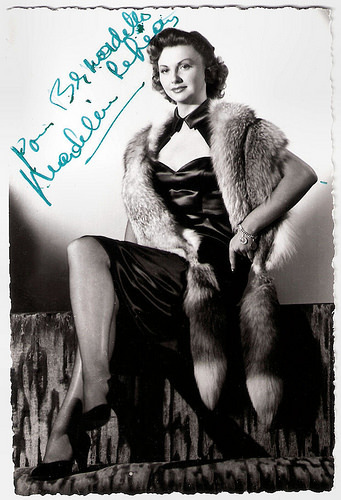
French autograph card.
Warner Bros
Marie Madeleine Berthe LeBeau was born in Antony, Hauts-de-Seine, France, in 1923 (some sources say 1921).
In her teens, she landed a tiny role in a play with Marcel Dalio , who was about 20 years her senior and struck by her beauty. They soon married. As Madeleine Lebeau she made her screen debut in the drama, Jeunes filles en détresse/Young Girls in Trouble (Georg Wilhelm Pabst, 1939).
In 1940, she fled Nazi-occupied France with Dalio. They left Paris just hours ahead of the invading German army; Dalio’s image had been used in Nazi posters to identify Jewish-looking features. They made their way to Lisbon and, using what turned out to be forged Chilean visas, booked passage on a Portuguese cargo ship, the Quanza, that was taking more than 300 refugees to the west.
Dalio and Lebeau eventually obtained temporary Canadian passports and ended up in the US. Due to Dalio’s connections in Hollywood with fellow French exiles such as Jean Renoir and Charles Boyer , they were both given Warner Bros contracts.
Lebeau made her Hollywood debut with a small part in Hold Back the Dawn (Mitchell Leisen, 1941), which starred Charles Boyer and Olivia de Havilland.
The following year, she appeared as glamorous Polish-born stage star Anna Held, the wife of Florenz Ziegfeld, in the Errol Flynn drama Gentleman Jim (Raoul Walsh, 1942) a biography of Irish-American boxer James J. Corbett.
With Marcel Dalio she appeared then in the classic Casablanca (Michael Curtiz, 1942). Lebeau played Yvonne, the French pushed-aside mistress of Rick Blaine, the owner of Rick’s Café Américain (Humphrey Bogart).
Neglected by Rick, a drunken Yvonne steps out with a German soldier, but she regains her moral compass. Wikipedia : “Lebeau's best moments in Casablanca are during the scene when French nationals sing ‘The Marseillaise’ drowning out the group of German soldiers singing a German folk song. The camera captures the (genuine) tears on her face, and later at the end of the anthem when she cries out Vive la France. France had fallen to Nazi forces, and many of the actors performing in the scene were real life refugees from Europe”.
Not long after finishing Casablanca, the then 19 years-old Lebeau and Dalio divorced. He filed suit, claiming desertion. Lebeau hoped Casablanca would catapult her to great demand in Hollywood. It did not.
As a freelancer, she earned supporting roles in the French underground drama Paris After Dark (Léonide Moguy, 1943) with George Sanders and Philip Dorn (Frits van Dongen), and her former husband. The film portrays the activities of the French resistance in Nazi-occupied Paris. Lebeau played a cafe owner who is secretly helping the resistance.
Ronald Bergan in The Guardian : “Besides brilliantly handling dramatic scenes, one with a slimy collaborator played by Dalio (they were then on the verge of a divorce), LeBeau, who had a fine singing voice, delivered a soulful ballad, My Paree.”
The following year, Lebeau had a smaller role in the musical comedy Music for Millions (Henry Koster, 1944) starring Margaret O'Brien. The film was nominated for an Academy Award in 1946. She also appeared on Broadway in the play The French Touch directed by René Clair.
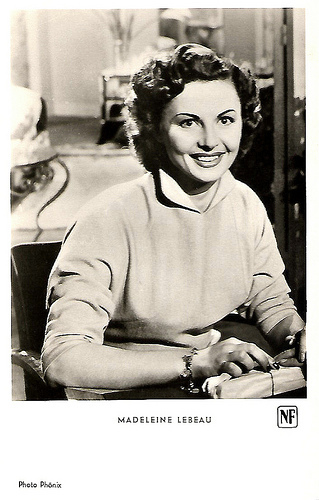
German postcard by Kunst und Bild, Berlin, no. A 787. Photo: Phönix / NF. Publicity still for Dupont Barbès/Sins of Paris (Henri Lepage, 1951).

German postcard by Ufa/Film-Foto, Berlin-Tempelhof, no. FK 683. Photo: d. H. Thibault / P.A.C. / Pathé Cinéma. Publicity still for Quai des blondes (Paul Cadéac, 1954).
Fellini
After the war, Madeleine Lebeau returned to Europe and appeared in 20 more films. These included Les Chouans/The Royalists (Henri Calef, 1947) and the English drama Cage of Gold (Basil Dearden, 1950) starring Jean Simmons .
Lebeau had a rare leading role in Dupont Barbès/Sins of Madeleine (Henri Lepage, 1951), about a prostitute who uses the ruse of pregnancy to end relationships with men, only to find one of her clients is delighted at the prospect of being a father.
She was in the all-star cast of Sacha Guitry ’s Napoleon (1955), and appeared in the bedroom farce Une Parisienne (Michel Boisrond, 1957), as Brigitte Bardot ’s romantic rival.
In 1956 she married a young businessman, Marcel Guez, but the marriage ended three years later in a divorce.
In Federico Fellini's avant-garde classic Otto e mezzo/8½ (1963) she played a French actress named Madeleine, one of the former loves of Guido Anselmi ( Marcello Mastroianni ) .
During the 1960s, she also appeared in the Spaghetti Western Desafío en Río Bravo/Gunmen of the Rio Grande (Tulio Demicheli, 1964) with Guy Madison and Angélique, marquise des anges/Angélique (Bernard Borderie, 1964), the first of the Angélique cycle starring Michèle Mercier .
Lebeau's film career ended with the Spanish production La vuelta/The return (José Luis Madrid, 1965). Her last turn before the cameras came in the French television series Allô police/Hello, Police (1969-1970).
After the filming of Otto e mezzo/8½ (1963) she stayed in Rome. In 1988 she married Italian screenwriter Tullio Pinelli who had co-written 8 1/2. He passed away in 2009 at 100.
After the death of her husband, Madeleine Lebeau moved to Estepona in the south of Spain. There she died in 2016 from complications following breaking her thigh bone. She was 92. A daughter, Maria Duhour Gil, survived her.
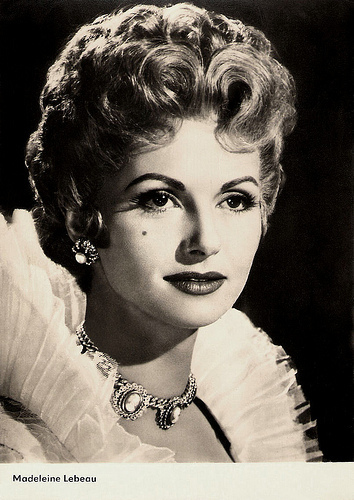
East-German postcard by VEB Progress Film-Vertrieb, Berlin, no. 1431. Photo: publicity still for La Picara Molinera/The Miller's Saucy Wife (Léon Klimovsky, 1955).
Scene from Casablanca (1942). Source: myyouyou111 (YouTube).
Sources: Ronald Bergan (The Guardian), Adam Bernstein (Washington Post), William Grimes (The New York Times), Frances D’Emilio and Lindsey Bahr (The Globe and Mail), Tom B. (Westerns...All'Italiana!), CineMemorial, BBC, Wikipedia and .

French postcard by Editions du Globe, no. 194. Photo: Sam Lévin.

French autograph card.
Warner Bros
Marie Madeleine Berthe LeBeau was born in Antony, Hauts-de-Seine, France, in 1923 (some sources say 1921).
In her teens, she landed a tiny role in a play with Marcel Dalio , who was about 20 years her senior and struck by her beauty. They soon married. As Madeleine Lebeau she made her screen debut in the drama, Jeunes filles en détresse/Young Girls in Trouble (Georg Wilhelm Pabst, 1939).
In 1940, she fled Nazi-occupied France with Dalio. They left Paris just hours ahead of the invading German army; Dalio’s image had been used in Nazi posters to identify Jewish-looking features. They made their way to Lisbon and, using what turned out to be forged Chilean visas, booked passage on a Portuguese cargo ship, the Quanza, that was taking more than 300 refugees to the west.
Dalio and Lebeau eventually obtained temporary Canadian passports and ended up in the US. Due to Dalio’s connections in Hollywood with fellow French exiles such as Jean Renoir and Charles Boyer , they were both given Warner Bros contracts.
Lebeau made her Hollywood debut with a small part in Hold Back the Dawn (Mitchell Leisen, 1941), which starred Charles Boyer and Olivia de Havilland.
The following year, she appeared as glamorous Polish-born stage star Anna Held, the wife of Florenz Ziegfeld, in the Errol Flynn drama Gentleman Jim (Raoul Walsh, 1942) a biography of Irish-American boxer James J. Corbett.
With Marcel Dalio she appeared then in the classic Casablanca (Michael Curtiz, 1942). Lebeau played Yvonne, the French pushed-aside mistress of Rick Blaine, the owner of Rick’s Café Américain (Humphrey Bogart).
Neglected by Rick, a drunken Yvonne steps out with a German soldier, but she regains her moral compass. Wikipedia : “Lebeau's best moments in Casablanca are during the scene when French nationals sing ‘The Marseillaise’ drowning out the group of German soldiers singing a German folk song. The camera captures the (genuine) tears on her face, and later at the end of the anthem when she cries out Vive la France. France had fallen to Nazi forces, and many of the actors performing in the scene were real life refugees from Europe”.
Not long after finishing Casablanca, the then 19 years-old Lebeau and Dalio divorced. He filed suit, claiming desertion. Lebeau hoped Casablanca would catapult her to great demand in Hollywood. It did not.
As a freelancer, she earned supporting roles in the French underground drama Paris After Dark (Léonide Moguy, 1943) with George Sanders and Philip Dorn (Frits van Dongen), and her former husband. The film portrays the activities of the French resistance in Nazi-occupied Paris. Lebeau played a cafe owner who is secretly helping the resistance.
Ronald Bergan in The Guardian : “Besides brilliantly handling dramatic scenes, one with a slimy collaborator played by Dalio (they were then on the verge of a divorce), LeBeau, who had a fine singing voice, delivered a soulful ballad, My Paree.”
The following year, Lebeau had a smaller role in the musical comedy Music for Millions (Henry Koster, 1944) starring Margaret O'Brien. The film was nominated for an Academy Award in 1946. She also appeared on Broadway in the play The French Touch directed by René Clair.

German postcard by Kunst und Bild, Berlin, no. A 787. Photo: Phönix / NF. Publicity still for Dupont Barbès/Sins of Paris (Henri Lepage, 1951).

German postcard by Ufa/Film-Foto, Berlin-Tempelhof, no. FK 683. Photo: d. H. Thibault / P.A.C. / Pathé Cinéma. Publicity still for Quai des blondes (Paul Cadéac, 1954).
Fellini
After the war, Madeleine Lebeau returned to Europe and appeared in 20 more films. These included Les Chouans/The Royalists (Henri Calef, 1947) and the English drama Cage of Gold (Basil Dearden, 1950) starring Jean Simmons .
Lebeau had a rare leading role in Dupont Barbès/Sins of Madeleine (Henri Lepage, 1951), about a prostitute who uses the ruse of pregnancy to end relationships with men, only to find one of her clients is delighted at the prospect of being a father.
She was in the all-star cast of Sacha Guitry ’s Napoleon (1955), and appeared in the bedroom farce Une Parisienne (Michel Boisrond, 1957), as Brigitte Bardot ’s romantic rival.
In 1956 she married a young businessman, Marcel Guez, but the marriage ended three years later in a divorce.
In Federico Fellini's avant-garde classic Otto e mezzo/8½ (1963) she played a French actress named Madeleine, one of the former loves of Guido Anselmi ( Marcello Mastroianni ) .
During the 1960s, she also appeared in the Spaghetti Western Desafío en Río Bravo/Gunmen of the Rio Grande (Tulio Demicheli, 1964) with Guy Madison and Angélique, marquise des anges/Angélique (Bernard Borderie, 1964), the first of the Angélique cycle starring Michèle Mercier .
Lebeau's film career ended with the Spanish production La vuelta/The return (José Luis Madrid, 1965). Her last turn before the cameras came in the French television series Allô police/Hello, Police (1969-1970).
After the filming of Otto e mezzo/8½ (1963) she stayed in Rome. In 1988 she married Italian screenwriter Tullio Pinelli who had co-written 8 1/2. He passed away in 2009 at 100.
After the death of her husband, Madeleine Lebeau moved to Estepona in the south of Spain. There she died in 2016 from complications following breaking her thigh bone. She was 92. A daughter, Maria Duhour Gil, survived her.

East-German postcard by VEB Progress Film-Vertrieb, Berlin, no. 1431. Photo: publicity still for La Picara Molinera/The Miller's Saucy Wife (Léon Klimovsky, 1955).
Scene from Casablanca (1942). Source: myyouyou111 (YouTube).
Sources: Ronald Bergan (The Guardian), Adam Bernstein (Washington Post), William Grimes (The New York Times), Frances D’Emilio and Lindsey Bahr (The Globe and Mail), Tom B. (Westerns...All'Italiana!), CineMemorial, BBC, Wikipedia and .
Published on June 18, 2018 22:00
June 17, 2018
New acquisitions at GDI: MGM Cine Stars
In addition to yesterday's post, Egbert Barten of the Geoffrey Donaldson Institute also lent me a postcard album, which the film institute acquired in January in Argenteuil, France. This album, 'MGM Cine Stars' was produced by the Belgian-Dutch chocolate factory Kwatta, on which we did this post in 2015. The pocket album contains some 100 collectors cards in black white of Metro-Goldwyn-Mayer stars of the 1940s. For this post, we selected 12 cards from the album. Some are numbered, some are not.
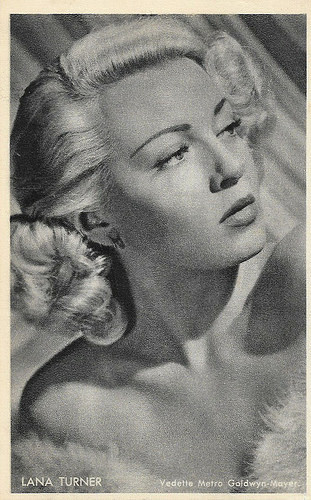
Lana Turner. Belgian collectors card by Kwatta, Bois d'Haine. Photo: Metro-Goldwyn-Mayer. Collection: Geoffrey Donaldson Institute.

Cyd Charisse. Belgian Collectors Card by Kwatta, Bois d'Haine, no. C. 36. Photo: Metro-Goldwyn-Mayer. Collection: Geoffrey Donaldson Institute.
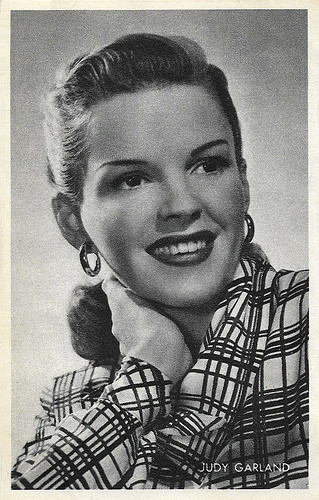
Judy Garland. Belgian collectors card by Kwatta, Bois d'Haine, no. C. 101. Photo: Metro-Goldwyn-Mayer. Collection: Geoffrey Donaldson Institute.
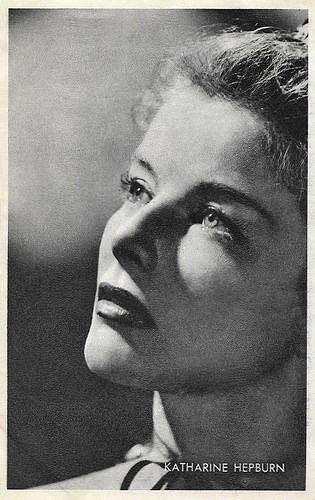
Katharine Hepburn. Belgian collectors card by Kwatta, Bois d'Haine, no. C. 110. Photo: Metro-Goldwyn-Mayer. Collection: Geoffrey Donaldson Institute.
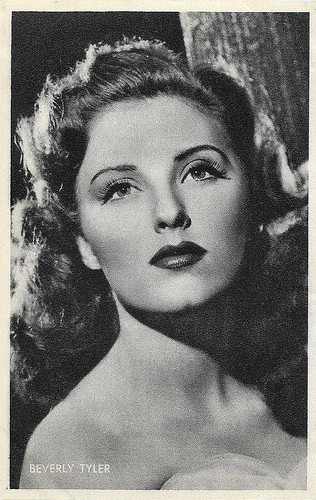
Beverly Tyler. Belgian collectors card by Kwatta, Bois d'Haine, no. C. 116. Photo: Metro-Goldwyn-Mayer. Publicity still for The Green Years (Victor Saville, 1946). Collection: Geoffrey Donaldson Institute.
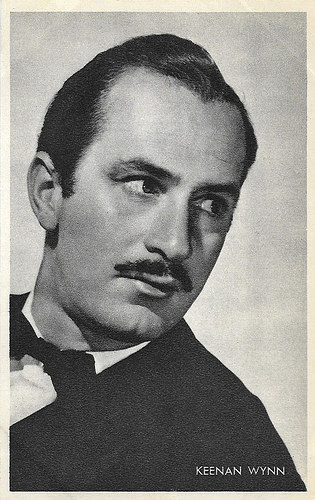
Keenan Wynn. Belgian collectors card by Kwatta, Bois d'Haine, no. C. 136. Photo: Metro-Goldwyn-Mayer. Collection: Geoffrey Donaldson Institute.
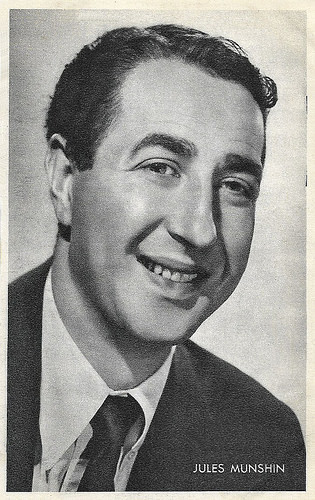
Jules Munshin. Belgian collectors card by Kwatta, Bois d'Haine, no. C. 143. Photo: Metro-Goldwyn-Mayer. Collection: Geoffrey Donaldson Institute. Publicity still for Easter Parade (Charles Walters, 1948).
Irene Dunne and Spencer Tracey. Belgian Collectors Card by Kwatta, Bois d'Haine, no. C. 158. Photo: Metro-Goldwyn-Mayer. Publicity still for A Guy Names Joe (Victor Fleming, 1943). Collection: Geoffrey Donaldson Institute.
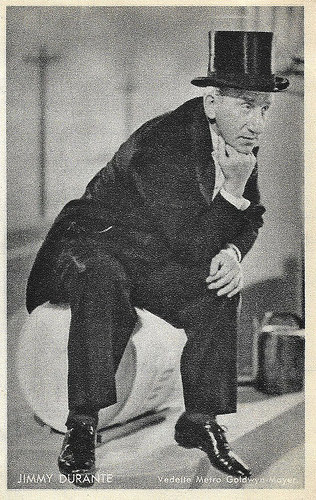
Jimmy Durante. Belgian Collectors Card by Kwatta, Bois d'Haine. Photo: Metro-Goldwyn-Mayer. Collection: Geoffrey Donaldson Institute.
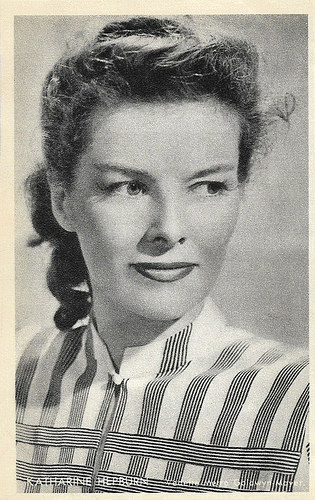
Katharine Hepburn. Belgian collectors card by Kwatta, Bois d'Haine. Photo: Metro-Goldwyn-Mayer. Collection: Geoffrey Donaldson Institute.
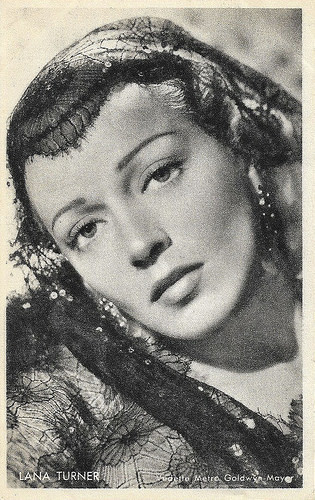
Lana Turner. Belgian collectors card by Kwatta, Bois d'Haine. Photo: Metro-Goldwyn-Mayer. Collection: Geoffrey Donaldson Institute.
MGM Cine Stars
Cine Stars Album for Belgian collectors cards with MGM stars by Kwatta, Bois d'Haine. Collection: Geoffrey Donaldson Institute. The Kwatta cards could be collected in this pocket album named 'Ciné Stars'. On the cover is the lion of Metro-Goldwyn-Mayer, the studio with more stars than the heavens. The short introduction in the album is both in French and in Dutch, the two languages of Belgium.
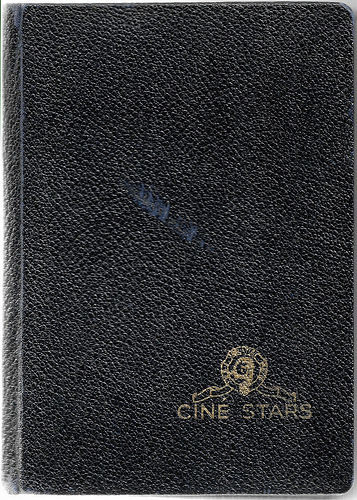
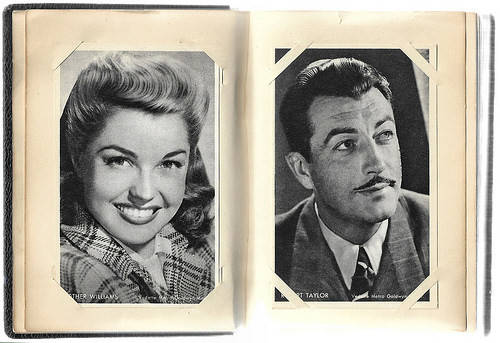
Egbert, thank you!

Lana Turner. Belgian collectors card by Kwatta, Bois d'Haine. Photo: Metro-Goldwyn-Mayer. Collection: Geoffrey Donaldson Institute.

Cyd Charisse. Belgian Collectors Card by Kwatta, Bois d'Haine, no. C. 36. Photo: Metro-Goldwyn-Mayer. Collection: Geoffrey Donaldson Institute.

Judy Garland. Belgian collectors card by Kwatta, Bois d'Haine, no. C. 101. Photo: Metro-Goldwyn-Mayer. Collection: Geoffrey Donaldson Institute.

Katharine Hepburn. Belgian collectors card by Kwatta, Bois d'Haine, no. C. 110. Photo: Metro-Goldwyn-Mayer. Collection: Geoffrey Donaldson Institute.

Beverly Tyler. Belgian collectors card by Kwatta, Bois d'Haine, no. C. 116. Photo: Metro-Goldwyn-Mayer. Publicity still for The Green Years (Victor Saville, 1946). Collection: Geoffrey Donaldson Institute.

Keenan Wynn. Belgian collectors card by Kwatta, Bois d'Haine, no. C. 136. Photo: Metro-Goldwyn-Mayer. Collection: Geoffrey Donaldson Institute.

Jules Munshin. Belgian collectors card by Kwatta, Bois d'Haine, no. C. 143. Photo: Metro-Goldwyn-Mayer. Collection: Geoffrey Donaldson Institute. Publicity still for Easter Parade (Charles Walters, 1948).
Irene Dunne and Spencer Tracey. Belgian Collectors Card by Kwatta, Bois d'Haine, no. C. 158. Photo: Metro-Goldwyn-Mayer. Publicity still for A Guy Names Joe (Victor Fleming, 1943). Collection: Geoffrey Donaldson Institute.

Jimmy Durante. Belgian Collectors Card by Kwatta, Bois d'Haine. Photo: Metro-Goldwyn-Mayer. Collection: Geoffrey Donaldson Institute.

Katharine Hepburn. Belgian collectors card by Kwatta, Bois d'Haine. Photo: Metro-Goldwyn-Mayer. Collection: Geoffrey Donaldson Institute.

Lana Turner. Belgian collectors card by Kwatta, Bois d'Haine. Photo: Metro-Goldwyn-Mayer. Collection: Geoffrey Donaldson Institute.
MGM Cine Stars
Cine Stars Album for Belgian collectors cards with MGM stars by Kwatta, Bois d'Haine. Collection: Geoffrey Donaldson Institute. The Kwatta cards could be collected in this pocket album named 'Ciné Stars'. On the cover is the lion of Metro-Goldwyn-Mayer, the studio with more stars than the heavens. The short introduction in the album is both in French and in Dutch, the two languages of Belgium.


Egbert, thank you!
Published on June 17, 2018 22:00
June 16, 2018
New acquisitions at GDI: Heinz Rühmann and other European stars
In Noord Schwarwoude, the Netherlands, there is small film institute we love, the Geoffrey Donaldson Institute (GDI). Our friend Egbert Barten is the managing director and he regularly shares new postcards from his collection with EFSP. Tomorrow we'll have a post on a postcard album he lately found in France. Today we do a post on a series of fine postcards plus a photo of the popular German film star Heinz Rühmann. The pictures plus the text for an article on Rühmann, were acquired from Dutch film journalist and collector Thijs Ockersen. We combine them with other new acquisitions by GDI and finish this post with one of the cards from the album on which we will focus tomorrow.
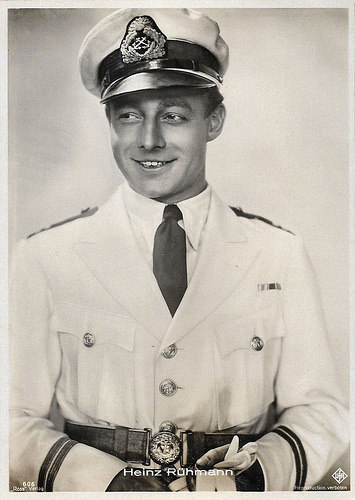
Heinz Rühmann in Bomben auf Monte Carlo (1931). German postcard by Ross Verlag, no. 606. Photo: Ufa. Publicity still for Bomben auf Monte Carlo/The Bombardment of Monte Carlo (Hanns Schwarz, 1931). Collection: Geoffrey Donaldson Institute.
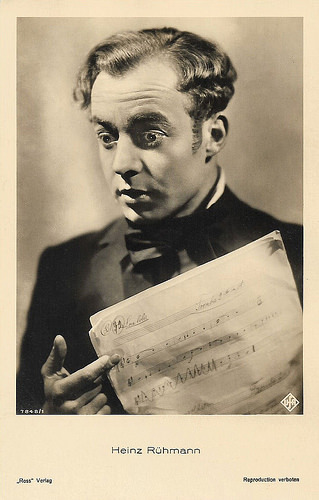
Heinz Rühmann in Ich und die Kaiserin (1933). German postcard by Ross Verlag, no. 7848/1, 1932-1933. Photo: Ufa. Publicity still for Ich und die Kaiserin/The Empress and I (Friedrich Hollaender, 1933). Collection: Geoffrey Donaldson Institute.
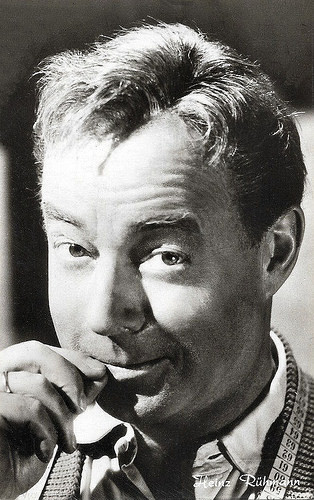
Heinz Rühmann in Kleider machen Leute (1940). Dutch postcard by I.F.P. (Drukkerij Uitg. Int. Filmpers), Amsterdam, no. 1243. Photo: publicity still for Kleider machen Leute/Clothes Make the Man (Helmut Käutner, 1940). Collection: Geoffrey Donaldson Institute.
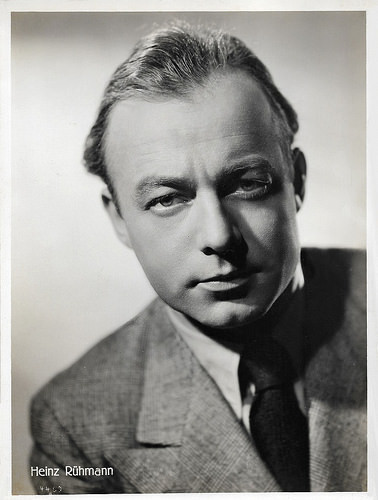
Heinz Rühmann . German photo. Collection: Geoffrey Donaldson Institute.
Heinz Rühmann
Actor, director and producer Heinz Rühmann (1902-1994) played in more than 100 films over nearly 70 years and was one of Germany's most popular film stars. He was a favourite actor of Adolf Hitler and Josef Goebbels but also of Anne Frank. She pasted his photo on the wall of her room in her family's hiding place during the war, where it can still be seen today.
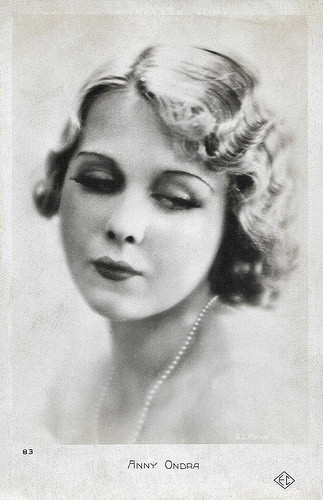
Anny Ondra . French postcard by EC, no. 83. Photo: G.L. Manuel Frères. Collection: Geoffrey Donaldson Institute.
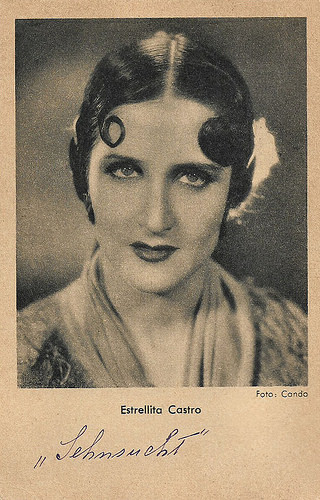
Estrellita Castro in El barbero de Sevilla (1938). German postcard by Das Programm von Heute / Ross Verlag, Berlin. Photo: Cando. Publicity still for El barbero de Sevilla/The Barber of Seville (Benito Perojo, 1938). Collection: Geoffrey Donaldson Institute.
Estrellita Castro
Estrellita Castro (1914-1983) was a Spanish 'tonadillera' (little tune singer) and actress, who had a stirring and passionate style. Born Estrella Castro Navarrete to a humble family, she started singing from an early age and busked around in Sevilla streets. She was yet known in Andalusia when she appeared in Barcelona in 1929 with a variety show named 'La copla andaluza', where she was the first star together with 'Ángel Sampedro 'Angelillo''. From that moment on she enjoyed success all over Spain, Europe and America. Castro became one of the greatest 'copla' (Spanish popular song) performers.
Estrellita Castro's success as a singer paved her way to the film industry, and she became one of the most popular and highly-paid Spanish actresses of the time. She made many folkloric musicals, including and La Maja del capote/ (Fernando Delgado, 1943). She starred in 40 films of which the most important were filmed in Germany - Suspiros de España/Sighs of Spain (Benito Perojo, 1938), El barbero de Sevilla/The Barber of Seville (Benito Perojo, 1938) both with Miguel Ligero, and Mariquilla Terremoto (Benito Perojo, 1939). The charm of her movements in the cinema together with her powerful acute voice and beauty conquered the public. One of the iconic features of her personal looks was a hair-curl on her forehead. After the war, she became a living myth of the Spanish music and cinema.
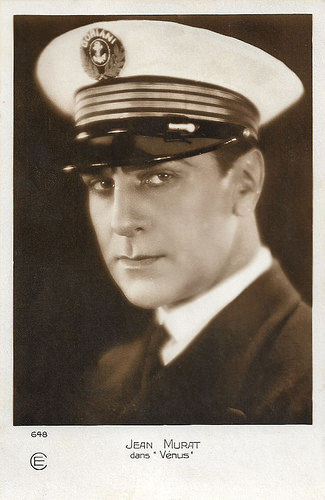
Jean Murat in Vénus (1929). French postcard by EC, no. 648. Photo publicity still for Vénus/Venus (Louis Mercanton, 1929). Collection: Geoffrey Donaldson Institute.
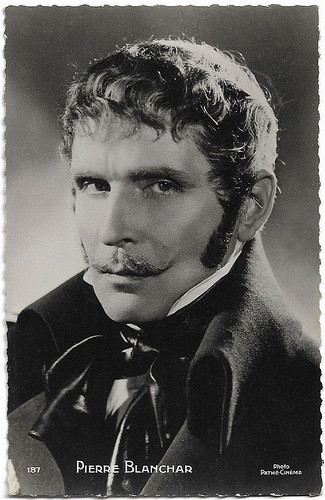
Pierre Blanchar in Pontcarral, Colonel d'Empire (1942). French postcard by Editions P.I., Paris, no. 187. Photo: Pathé Cinéma, Pierre Blanchar in Pontcarral, colonel d'empire/Pontcarral, colonel of the empire (Jean Delannoy, 1942). Collection: Geoffrey Donaldson Institute.
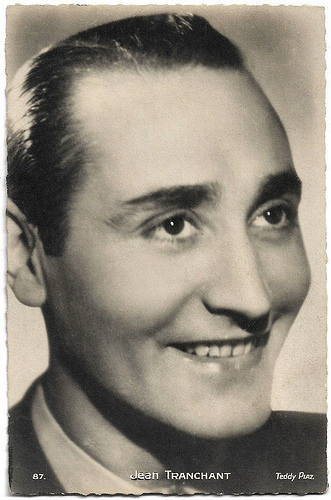
Jean Tranchant. French postcard by Editions O.P., Paris, no. 87. Photo: Teddy Piaz. Collection: Geoffrey Donaldson Institute.
Jean Tranchant
Jean Tranchant (1904-1972) was a French singer-composer, poster designer and painter, who also incidentally acted in films. Tranchant wrote songs for Lucienne Boyer (La Barque d'Yves, Moi j'crache dans l'eau), then for Marianne Oswald (Appel, La Complainte de Kesoubah, Sans repentir), Marlène Dietrich (Assez) and Lys Gauty. He performed with his wife Simone Naudet. Many of his songs were used in French films, and he also composed for the soundtrack of such films as Fanatisme (Tony Lekain, Gaston Ravel, 1934), starring Pola Negri . Tranchant himself starred in the film musical Ici l'on pêche (René Jayet, 1941) with Jane Sourza.
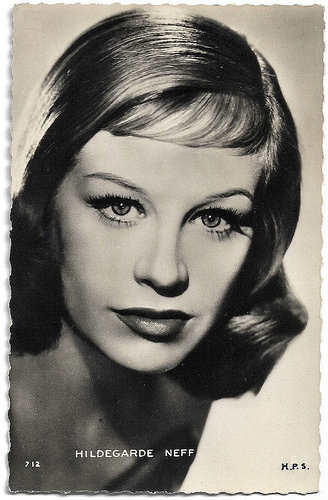
Hildegard Knef . French postcard by Edition P.I., offered by Les Carbones Korès Carboplane, no. 712. Photo: H.P.S. Collection: Geoffrey Donaldson Institute.
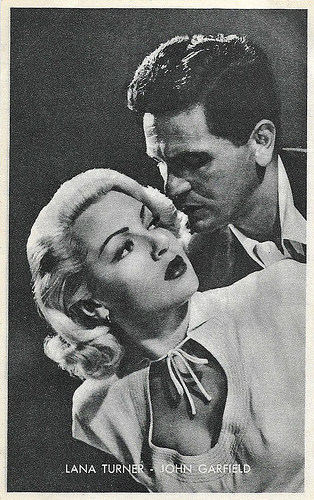
Lana Turner and John Garfield in The Postman Always Rings Twice (1946). Belgian Collectors Card by Kwatta, Bois d'Haine, no. C. 173. Photo: Metro-Goldwyn-Mayer. Collection: Geoffrey Donaldson Institute. Publicity still for The Postman Always Rings Twice (Tay Garnett, 1946).
Egbert, thank you!

Heinz Rühmann in Bomben auf Monte Carlo (1931). German postcard by Ross Verlag, no. 606. Photo: Ufa. Publicity still for Bomben auf Monte Carlo/The Bombardment of Monte Carlo (Hanns Schwarz, 1931). Collection: Geoffrey Donaldson Institute.

Heinz Rühmann in Ich und die Kaiserin (1933). German postcard by Ross Verlag, no. 7848/1, 1932-1933. Photo: Ufa. Publicity still for Ich und die Kaiserin/The Empress and I (Friedrich Hollaender, 1933). Collection: Geoffrey Donaldson Institute.

Heinz Rühmann in Kleider machen Leute (1940). Dutch postcard by I.F.P. (Drukkerij Uitg. Int. Filmpers), Amsterdam, no. 1243. Photo: publicity still for Kleider machen Leute/Clothes Make the Man (Helmut Käutner, 1940). Collection: Geoffrey Donaldson Institute.

Heinz Rühmann . German photo. Collection: Geoffrey Donaldson Institute.
Heinz Rühmann
Actor, director and producer Heinz Rühmann (1902-1994) played in more than 100 films over nearly 70 years and was one of Germany's most popular film stars. He was a favourite actor of Adolf Hitler and Josef Goebbels but also of Anne Frank. She pasted his photo on the wall of her room in her family's hiding place during the war, where it can still be seen today.

Anny Ondra . French postcard by EC, no. 83. Photo: G.L. Manuel Frères. Collection: Geoffrey Donaldson Institute.

Estrellita Castro in El barbero de Sevilla (1938). German postcard by Das Programm von Heute / Ross Verlag, Berlin. Photo: Cando. Publicity still for El barbero de Sevilla/The Barber of Seville (Benito Perojo, 1938). Collection: Geoffrey Donaldson Institute.
Estrellita Castro
Estrellita Castro (1914-1983) was a Spanish 'tonadillera' (little tune singer) and actress, who had a stirring and passionate style. Born Estrella Castro Navarrete to a humble family, she started singing from an early age and busked around in Sevilla streets. She was yet known in Andalusia when she appeared in Barcelona in 1929 with a variety show named 'La copla andaluza', where she was the first star together with 'Ángel Sampedro 'Angelillo''. From that moment on she enjoyed success all over Spain, Europe and America. Castro became one of the greatest 'copla' (Spanish popular song) performers.
Estrellita Castro's success as a singer paved her way to the film industry, and she became one of the most popular and highly-paid Spanish actresses of the time. She made many folkloric musicals, including and La Maja del capote/ (Fernando Delgado, 1943). She starred in 40 films of which the most important were filmed in Germany - Suspiros de España/Sighs of Spain (Benito Perojo, 1938), El barbero de Sevilla/The Barber of Seville (Benito Perojo, 1938) both with Miguel Ligero, and Mariquilla Terremoto (Benito Perojo, 1939). The charm of her movements in the cinema together with her powerful acute voice and beauty conquered the public. One of the iconic features of her personal looks was a hair-curl on her forehead. After the war, she became a living myth of the Spanish music and cinema.

Jean Murat in Vénus (1929). French postcard by EC, no. 648. Photo publicity still for Vénus/Venus (Louis Mercanton, 1929). Collection: Geoffrey Donaldson Institute.

Pierre Blanchar in Pontcarral, Colonel d'Empire (1942). French postcard by Editions P.I., Paris, no. 187. Photo: Pathé Cinéma, Pierre Blanchar in Pontcarral, colonel d'empire/Pontcarral, colonel of the empire (Jean Delannoy, 1942). Collection: Geoffrey Donaldson Institute.

Jean Tranchant. French postcard by Editions O.P., Paris, no. 87. Photo: Teddy Piaz. Collection: Geoffrey Donaldson Institute.
Jean Tranchant
Jean Tranchant (1904-1972) was a French singer-composer, poster designer and painter, who also incidentally acted in films. Tranchant wrote songs for Lucienne Boyer (La Barque d'Yves, Moi j'crache dans l'eau), then for Marianne Oswald (Appel, La Complainte de Kesoubah, Sans repentir), Marlène Dietrich (Assez) and Lys Gauty. He performed with his wife Simone Naudet. Many of his songs were used in French films, and he also composed for the soundtrack of such films as Fanatisme (Tony Lekain, Gaston Ravel, 1934), starring Pola Negri . Tranchant himself starred in the film musical Ici l'on pêche (René Jayet, 1941) with Jane Sourza.

Hildegard Knef . French postcard by Edition P.I., offered by Les Carbones Korès Carboplane, no. 712. Photo: H.P.S. Collection: Geoffrey Donaldson Institute.

Lana Turner and John Garfield in The Postman Always Rings Twice (1946). Belgian Collectors Card by Kwatta, Bois d'Haine, no. C. 173. Photo: Metro-Goldwyn-Mayer. Collection: Geoffrey Donaldson Institute. Publicity still for The Postman Always Rings Twice (Tay Garnett, 1946).
Egbert, thank you!
Published on June 16, 2018 22:00
June 15, 2018
Photo by Raymond Voinquel
From this Saturday on, EFSP continues the series Photo by... on photographers. We start with French photographer Raymond Voinquel (1912-1994). For over 40 years, he collaborated with the greatest directors in and out of France, including Marcel l’Herbier, Jean Cocteau, Abel Gance, Max Ophüls, Jean Renoir, Marcel Carné, Sacha Guitry and Jean-Pierre Melville. In addition to his work as a stills photographer for 160 films, Voinquel also worked with Studio Harcourt as a portrait photographer of the stars. And he made sensual male nudes of France’s most handsome stars.
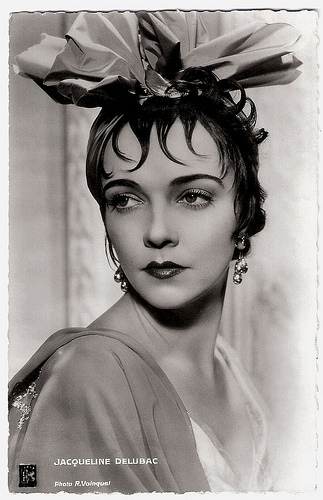
Jacqueline Delubac . French postcard by Editions et Publications cinématographiques (EPC), no. 142. Photo: Raymond Voinquel.
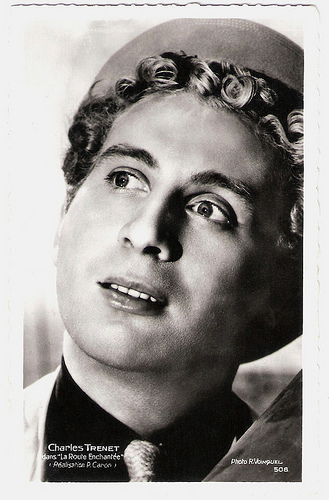
Charles Trenet . French postcard by Edit. Chantal, Rueil, no. 508. Photo: Raymond Voinquel. Publicity still for La route enchantée/The enchanted road (Pierre Caron, 1938).
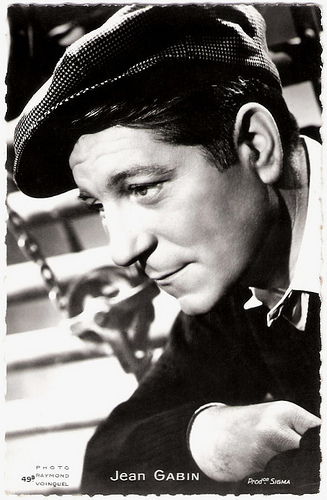
Jean Gabin . French postcard by Edit. Chantal, Rueil (S.-O.), no, 49B. Photo: Raymond Voinquel / Sigma. Publicity still for Le jour se lève/Daybreak (Marcel Carne, 1939),
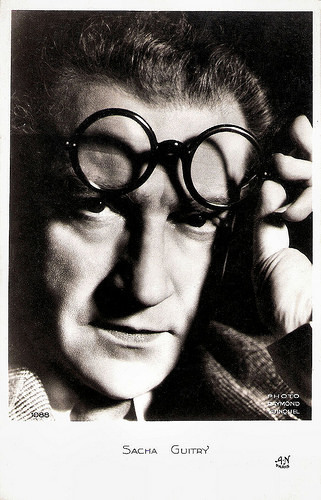
Sacha Guitry . French postcard by A. Noyer (A.N.), Paris, no. 1088. Photo: Raymond Voinquel.
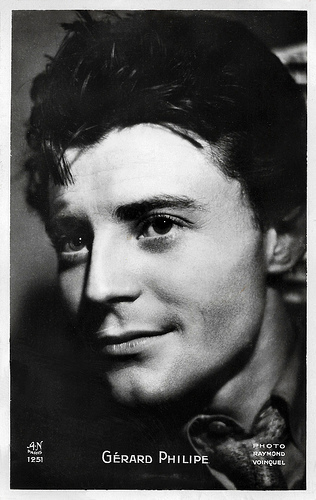
Gérard Philipe . French postcard by A. Noyer (A.N.), Paris, no. 1261. Photo: Raymond Voinquel.
Back and forth between fashion and cinema
Raymond Voinquel was born in 1912 in Fraize, a commune in the Vosges department in Grand Est in northeastern France.
In 1927, after the divorce of his parents, he moved with his mother to Paris. Attracted to the cinema, he became an extra in films by Jean Grémillon and Henri Fescourt.
In the famous Brasserie La Coupole, he met his first model: Hollywood star Adolphe Menjou . With him, he made his first actor portrait in front of the Majestic hotel. Menjou was in Paris to shoot the French film Mon gosse de père/My Kid of a Father (Jean De Limur, 1930) at the Joinville studios.
In 1930, Voinquel became an assistant to photographer Roger Forster, pioneer of film photography. However, Voinquel quited the job after only two months. He chose to become himself a stills photographer for the cinema. His first assignment was Mon amant l'assassin/My lover the murderer (Solange Bussy, 1931).
Around 1935, Voinquel also tried his hand at fashion photography. He used it as a means for experimentation, drawing directly on his negatives, or being the first photographer in France to take his models out of the studio and into the streets. He worked together as a team with George Hoyningen-Huene and Horst, and made photos for magazines like Silhouette, Harper’s Bazaar and Vogue.
He went back and forth between his work in fashion and cinema, his goal always being to transform the given into dream-like images. It didn’t take long for Voinquel to abandon fashion and dedicate himself entirely to the cinema. He threw himself completely into projects as soon as they were thought of by writers or directors, and was at times responsible for the meetings between them and the stars; he was thus the catalyst for the advent of certain films.
During the 1930s and 1940s, he was the stills photographer on films by director Marcel Carné, such as Le jour se lève/Daybreak (1939) with Jean Gabin , and Les Portes de la nuit/Gates of the Night (1946) with Yves Montand . He worked for Max Ophüls at Sans lendemain/There's No Tomorrow (1940) with Edwige Feuillère , and for Jean Cocteau at L'Aigle à deux têtes/The Eagle Has Two Heads (1948) with Feuillère and Jean Marais .
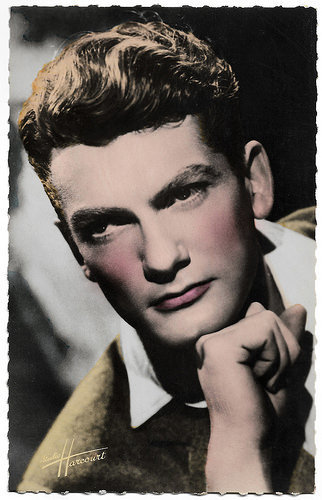
Jean Marais . French postcard by Editions O.P., Paris, no. 21. Photo: Raymond Voinquel / Studio Harcourt.
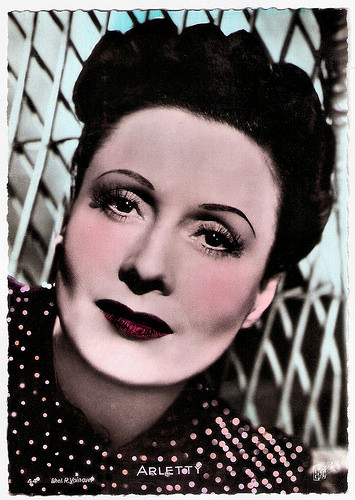
Arletty . French postcard by Editions et Publications cinématographiques (EPC), no. 44. Photo: Raymond Voinquel.
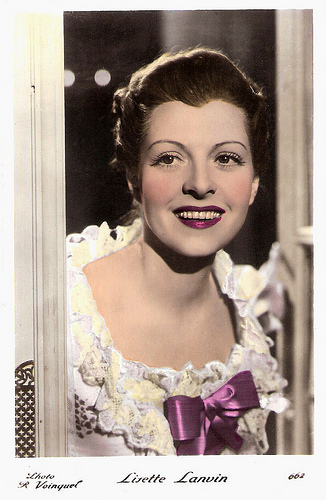
Lisette Lanvin . French postcard, no. 662. Photo: Raymond Voinquel.
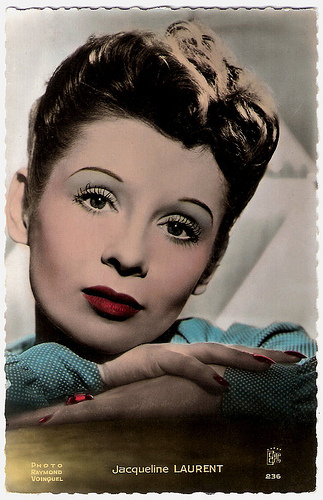
Jacqueline Laurent . French postcard by Editions et Publications cinématographiques (EPC), no. 236. Photo: Raymond Voinquel.
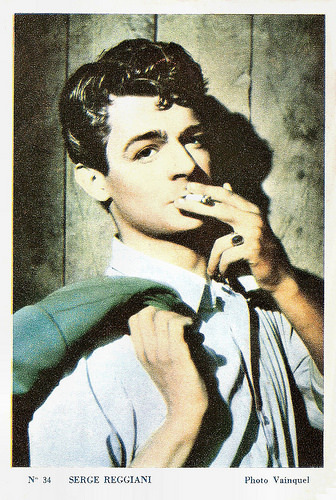
Serge Reggiani . Belgian collectors card by Merbotex, Bruxelles / Kursaal, Bertrix, no. 34. Photo: Raymond Voinquel.
Sensual, erotic and tasteful male nudes
During the Second World War, Raymond Voinquel went to work at Studio Harcourt, where he joined Roger Forster and Aldo Graziati . The work he did there did not delight him too much. The pace was frantic and Voinquel for whom photography was a craft could not really accommodate. He also denied the existence of a Harcourt style.
For him, the important thing was to know the person he was photographing to give a result closer to reality, to truth. His favourite actress was Danielle Darrieux .
Louis Jourdan , Jean Marais and Jacques Sernas posed naked for him and the results are still sensual, erotic and tasteful. Voinquel made several photographs of male nudes. In 1940, he planned to illustrate Narcisse, a poem by Paul Valéry. In 1941, he photographed athletes at the Bordeaux stadium. He also paid tribute to Michelangelo through another series of male nude photographs.
He was the cinematographer for the film Saint-Louis, ange de la paix/Saint Louis, Angel of Peace (Robert Darène, 1951) which ran in cinemas with Jean Cocteau’s Orphée (1950). It shows Saint Louis’ life through statues, landscapes, and chateaux from the period. Voinquel also directed some films himself. He made a short documentary film on Norway called Le Bout du Monde/The End of the Earth (1952). In 1954, he made a documentary on Gustave Doré, his life and work. Unfortunately he had to cut back the film from 90 to 60 minutes. It ran for three months at the Ursulines, one of the oldest art cinemas in Paris.
During the 1950s, Voinquel worked as still photographer for several films by Yves Allégret, including Les Orgueilleux/The Proud and the Beautiful (1953) with Michèle Morgan and Gérard Philipe . He also reunited with Max Ophüls for Lola Montès (1955) featuring Martine Carol .
Voinquel photographed several times for director Jean-Pierre Melville, including the stills for the thriller Le Doulos/The Finger Man (1962) starring Jean-Paul Belmondo . His other major films assignments of the 1960s included Austerlitz (Abel Gance, 1960), and Belle de Jour (Luis Buñuel, 1963) starring Catherine Deneuve .
From 1931 to 1979, Voinquel created the stills for 160 films. International directors with whom he worked were Carol Reed, Anatole Litvak, Billy Wilder, Joseph L. Mankiewicz and Alfred Hitchcock. His final film was the opera adaptation Fidelio (Pierre Jourdan, 1979). In 1989, the Cannes Film Festival awarded him for his photographic oeuvre.
Raymond Voinquel died in 1994 in Paris. He was 82.
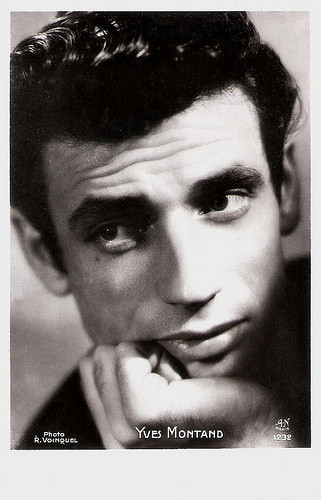
Yves Montand . French postcard by A. Noyer (A.N.), Paris, no. 1232. Photo: Raymond Voinquel.
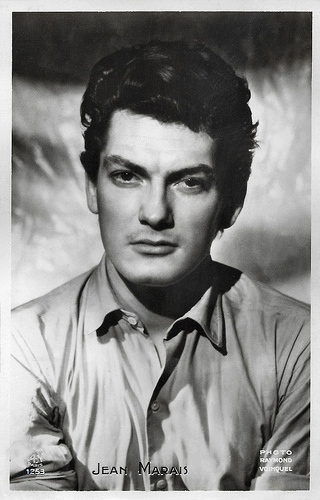
Jean Marais . French postcard by A. Noyer (A.N.), Paris, no. 1253. Photo: Raymond Voinquel.
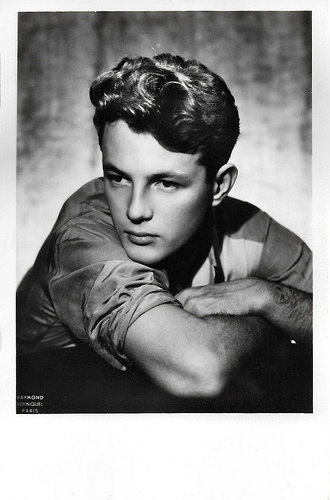
Jacques Sernas . French postcard by A. Noyer (A.N.), Paris, no. 1299. Photo: Raymond Voinquel.
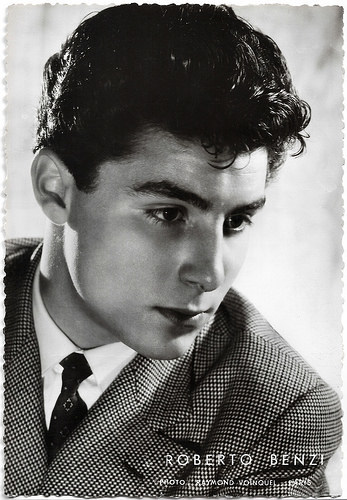
Roberto Benzi . French postcard. Photo: Raymond Voinquel, Paris.
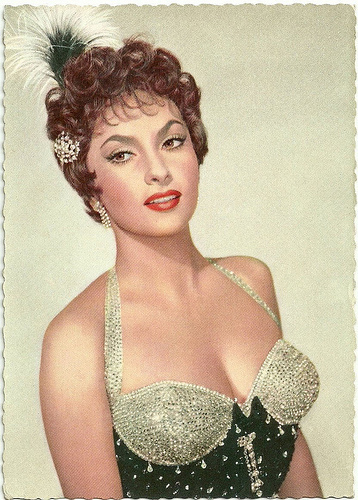
Gina Lollobrigida . German postcard by Ufa, no. CK 67. Photo: Raymond Voinquel. Publicity still for Trapeze (Carol Reed, 1956).
Sources: Samia Saouma (Bomb), CinéRessources (French), Tribute site to Raymond Voinquel, Wikipedia (French) and .

Jacqueline Delubac . French postcard by Editions et Publications cinématographiques (EPC), no. 142. Photo: Raymond Voinquel.

Charles Trenet . French postcard by Edit. Chantal, Rueil, no. 508. Photo: Raymond Voinquel. Publicity still for La route enchantée/The enchanted road (Pierre Caron, 1938).

Jean Gabin . French postcard by Edit. Chantal, Rueil (S.-O.), no, 49B. Photo: Raymond Voinquel / Sigma. Publicity still for Le jour se lève/Daybreak (Marcel Carne, 1939),

Sacha Guitry . French postcard by A. Noyer (A.N.), Paris, no. 1088. Photo: Raymond Voinquel.

Gérard Philipe . French postcard by A. Noyer (A.N.), Paris, no. 1261. Photo: Raymond Voinquel.
Back and forth between fashion and cinema
Raymond Voinquel was born in 1912 in Fraize, a commune in the Vosges department in Grand Est in northeastern France.
In 1927, after the divorce of his parents, he moved with his mother to Paris. Attracted to the cinema, he became an extra in films by Jean Grémillon and Henri Fescourt.
In the famous Brasserie La Coupole, he met his first model: Hollywood star Adolphe Menjou . With him, he made his first actor portrait in front of the Majestic hotel. Menjou was in Paris to shoot the French film Mon gosse de père/My Kid of a Father (Jean De Limur, 1930) at the Joinville studios.
In 1930, Voinquel became an assistant to photographer Roger Forster, pioneer of film photography. However, Voinquel quited the job after only two months. He chose to become himself a stills photographer for the cinema. His first assignment was Mon amant l'assassin/My lover the murderer (Solange Bussy, 1931).
Around 1935, Voinquel also tried his hand at fashion photography. He used it as a means for experimentation, drawing directly on his negatives, or being the first photographer in France to take his models out of the studio and into the streets. He worked together as a team with George Hoyningen-Huene and Horst, and made photos for magazines like Silhouette, Harper’s Bazaar and Vogue.
He went back and forth between his work in fashion and cinema, his goal always being to transform the given into dream-like images. It didn’t take long for Voinquel to abandon fashion and dedicate himself entirely to the cinema. He threw himself completely into projects as soon as they were thought of by writers or directors, and was at times responsible for the meetings between them and the stars; he was thus the catalyst for the advent of certain films.
During the 1930s and 1940s, he was the stills photographer on films by director Marcel Carné, such as Le jour se lève/Daybreak (1939) with Jean Gabin , and Les Portes de la nuit/Gates of the Night (1946) with Yves Montand . He worked for Max Ophüls at Sans lendemain/There's No Tomorrow (1940) with Edwige Feuillère , and for Jean Cocteau at L'Aigle à deux têtes/The Eagle Has Two Heads (1948) with Feuillère and Jean Marais .

Jean Marais . French postcard by Editions O.P., Paris, no. 21. Photo: Raymond Voinquel / Studio Harcourt.

Arletty . French postcard by Editions et Publications cinématographiques (EPC), no. 44. Photo: Raymond Voinquel.

Lisette Lanvin . French postcard, no. 662. Photo: Raymond Voinquel.

Jacqueline Laurent . French postcard by Editions et Publications cinématographiques (EPC), no. 236. Photo: Raymond Voinquel.

Serge Reggiani . Belgian collectors card by Merbotex, Bruxelles / Kursaal, Bertrix, no. 34. Photo: Raymond Voinquel.
Sensual, erotic and tasteful male nudes
During the Second World War, Raymond Voinquel went to work at Studio Harcourt, where he joined Roger Forster and Aldo Graziati . The work he did there did not delight him too much. The pace was frantic and Voinquel for whom photography was a craft could not really accommodate. He also denied the existence of a Harcourt style.
For him, the important thing was to know the person he was photographing to give a result closer to reality, to truth. His favourite actress was Danielle Darrieux .
Louis Jourdan , Jean Marais and Jacques Sernas posed naked for him and the results are still sensual, erotic and tasteful. Voinquel made several photographs of male nudes. In 1940, he planned to illustrate Narcisse, a poem by Paul Valéry. In 1941, he photographed athletes at the Bordeaux stadium. He also paid tribute to Michelangelo through another series of male nude photographs.
He was the cinematographer for the film Saint-Louis, ange de la paix/Saint Louis, Angel of Peace (Robert Darène, 1951) which ran in cinemas with Jean Cocteau’s Orphée (1950). It shows Saint Louis’ life through statues, landscapes, and chateaux from the period. Voinquel also directed some films himself. He made a short documentary film on Norway called Le Bout du Monde/The End of the Earth (1952). In 1954, he made a documentary on Gustave Doré, his life and work. Unfortunately he had to cut back the film from 90 to 60 minutes. It ran for three months at the Ursulines, one of the oldest art cinemas in Paris.
During the 1950s, Voinquel worked as still photographer for several films by Yves Allégret, including Les Orgueilleux/The Proud and the Beautiful (1953) with Michèle Morgan and Gérard Philipe . He also reunited with Max Ophüls for Lola Montès (1955) featuring Martine Carol .
Voinquel photographed several times for director Jean-Pierre Melville, including the stills for the thriller Le Doulos/The Finger Man (1962) starring Jean-Paul Belmondo . His other major films assignments of the 1960s included Austerlitz (Abel Gance, 1960), and Belle de Jour (Luis Buñuel, 1963) starring Catherine Deneuve .
From 1931 to 1979, Voinquel created the stills for 160 films. International directors with whom he worked were Carol Reed, Anatole Litvak, Billy Wilder, Joseph L. Mankiewicz and Alfred Hitchcock. His final film was the opera adaptation Fidelio (Pierre Jourdan, 1979). In 1989, the Cannes Film Festival awarded him for his photographic oeuvre.
Raymond Voinquel died in 1994 in Paris. He was 82.

Yves Montand . French postcard by A. Noyer (A.N.), Paris, no. 1232. Photo: Raymond Voinquel.

Jean Marais . French postcard by A. Noyer (A.N.), Paris, no. 1253. Photo: Raymond Voinquel.

Jacques Sernas . French postcard by A. Noyer (A.N.), Paris, no. 1299. Photo: Raymond Voinquel.

Roberto Benzi . French postcard. Photo: Raymond Voinquel, Paris.

Gina Lollobrigida . German postcard by Ufa, no. CK 67. Photo: Raymond Voinquel. Publicity still for Trapeze (Carol Reed, 1956).
Sources: Samia Saouma (Bomb), CinéRessources (French), Tribute site to Raymond Voinquel, Wikipedia (French) and .
Published on June 15, 2018 22:00
June 14, 2018
Betty Bird
Betty Bird (1901-1998) was a beautiful Austrian actress who appeared in several German films between 1927 and 1935.
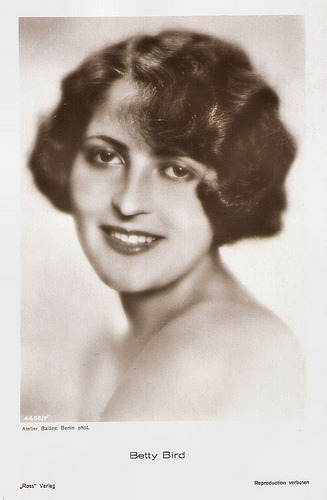
German postcard by Ross Verlag, no. 4456/1, 1929-1930. Photo: Atelier Balázs, Berlin.
The Viennese Film Beauty Queen
Betty Bird was born in 1901 in Vienna, Austria-Hungary (now Austria) as Hilde Elisabeth Ptack. She was the daughter of Ludwig Ptack, the private secretary of Count Alexander Kolowrat-Krakowsky, the owner of the Sascha Film Factory. Thus Betty came into contact with film people at an early age.
In 1923, she married the cameraman and later film director Gustav Ucicky. In 1927 she became the ‘Viennese Film Beauty Queen’ and received a first film offer and debuted in Madame wagt einen Seitensprung/Madame makes an infidelity (Hans Otto, 1927), starring Xenia Desni . She now called herself Betty Bird.
With her husband she moved to Munich and later to Berlin. She made Der Ladenprinz/The Shop Prince (Erich Schönfelder, 1928), in which she played the cousin of Harry Halm .
Then followed a leading role in the German-Spanish silent film Herzen ohne Ziel/Corazones sin rumbo/Restless Hearts (Benito Perojo, Gustav Ucicky, 1928) in which she starred with Hanna Ralph and Livio Pavanelli .
The film was a co-production between the Spanish company Julio César and the German studio Bavaria Film. The Argentine actress Imperio Argentina was cast after winning a competition staged by the film's producers. On its release the film was attacked by Spanish critics who felt that the Spanish actors had been relegated to lesser roles.
She then appeared in the German production Der Herzensphotograph/The Heart Photographer (Max Reichmann, 1928) co-starring with Harry Liedtke , Robert Garrison and La Jana .
In the silent crime film Das grüne Monokel/The Green Monocle (Rudolf Meinert, 1929), she starred with Ralph Cancy and Suzy Vernon . It features Stuart Webbs, one of several German fictional detectives inspired by Sherlock Holmes, who had appeared in a series of silent German films during the 1910s and 1920s. Die Mitternachtstaxe/Taxi at Midnight (Harry Piel, 1929) is another German silent thriller in which she appeared opposite Harry Piel .
In Austria, she starred in the silent comedy Madame im Strandbad/Lady in the Spa (Edmund Hahn, 1929) about a small spa town, which tries to give the impression that it is actually a much more important place than it really is. Back in Germany she starred in the comedy Die vierte von rechts/The Fourth from the Right (Conrad Wiene, 1929) with Ossi Oswalda and Adolphe Engers .
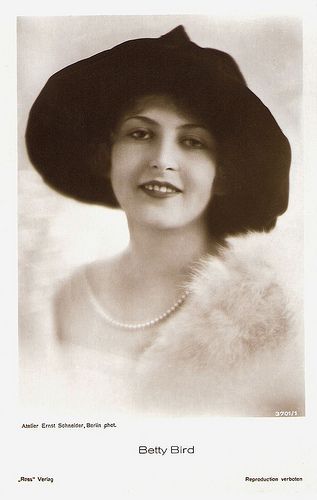
German postcard by Ross Verlag, no. 3701/1, 1928-1929. Photo: Ernst Schneider, Berlin.
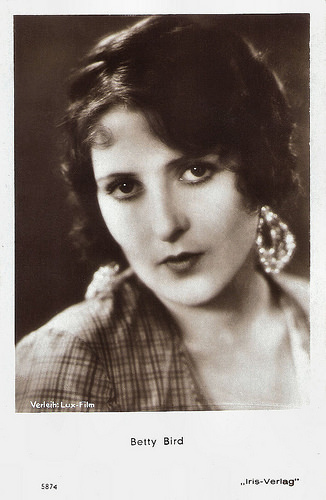
Austrian postcard by Iris-Verlag, no. 5874. Photo: Lux-Film.
An operetta wave
Betty Bird smoothly moved into the sound era. She had a supporting part in the musical drama Liebling der Götter/Darling of the Gods (Hanns Schwarz, 1930) starring Emil Jannings , Renate Müller and Olga Tschechova .
Then followed a female lead opposite Hans Brausewetter and Willi Forst in the musical Ein Burschenlied aus Heidelberg/A Student's Song of Heidelberg (Karl Hartl, 1930) in the tradition of the nostalgic Old Heidelberg.
In the German drama Grock (Carl Boese, 1931), she co-starred with the famous Swiss circus clown Grock (as himself) and Liane Haid . She then starred in the farce Die spanische Fliege/The Spanish Fly (Georg Jacoby, 1931) with Lizzi Waldmüller and Fritz Schulz .
She had a supporting role in Opernredoute/The Opera Ball (Max Neufeld, 1931) starring Iván Petrovich , Liane Haid and Georg Alexander . It is an adaptation of the operetta Der Opernball and part of the many operetta films made during the decade.
In the following years she mainly played supporting parts, such as in the operetta Kaiserwalzer/The Emperor's Waltz (Friedrich Zelnik (Frederic Zelnik), 1933) starring Márta Eggerth, Paul Hörbiger and Willy Eichberger a.k.a. Carl Esmond.
Her final film was the Czech-German comedy Held einer Nacht/Hero of one Night (Martin Frič, 1935) with Vlasta Burian and Theo Lingen . In 1936, her marriage with Gustav Ucicky ended in a divorce.
In 1937, Bird married the Czech dentist Hruska in Rome. She retired from the film industry and lived in Italy till her death. Betty Bird passed away in Rome in 1998. She was 96.
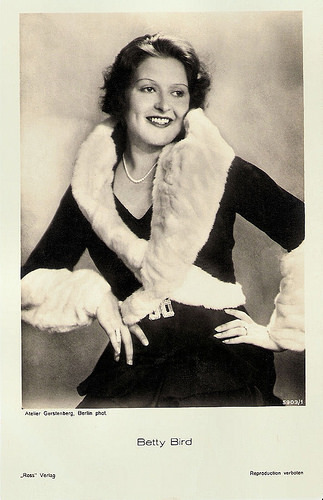
German postcard by Ross Verlag, no. 5903/1, 1930-1931. Photo: Atelier Gerstenberg, Berlin.
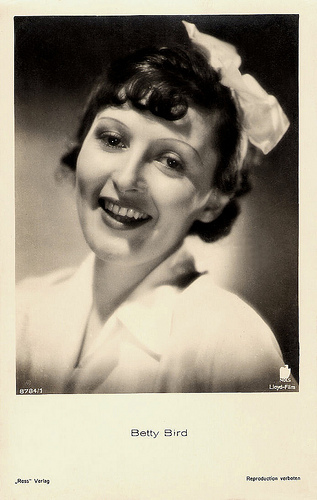
German postcard by Ross Verlag, no. 8784/1, 1933-1934. Photo: Lloyd-Film / Neue Deutsch Lichtspiel-Syndikat. Publicity still for Was bin ich ohne Dich/What Am I Without You (Arthur Maria Rabenalt, 1934).
Sources: Thomas Staedeli (Cyranos), Wikipedia (German and English), and .

German postcard by Ross Verlag, no. 4456/1, 1929-1930. Photo: Atelier Balázs, Berlin.
The Viennese Film Beauty Queen
Betty Bird was born in 1901 in Vienna, Austria-Hungary (now Austria) as Hilde Elisabeth Ptack. She was the daughter of Ludwig Ptack, the private secretary of Count Alexander Kolowrat-Krakowsky, the owner of the Sascha Film Factory. Thus Betty came into contact with film people at an early age.
In 1923, she married the cameraman and later film director Gustav Ucicky. In 1927 she became the ‘Viennese Film Beauty Queen’ and received a first film offer and debuted in Madame wagt einen Seitensprung/Madame makes an infidelity (Hans Otto, 1927), starring Xenia Desni . She now called herself Betty Bird.
With her husband she moved to Munich and later to Berlin. She made Der Ladenprinz/The Shop Prince (Erich Schönfelder, 1928), in which she played the cousin of Harry Halm .
Then followed a leading role in the German-Spanish silent film Herzen ohne Ziel/Corazones sin rumbo/Restless Hearts (Benito Perojo, Gustav Ucicky, 1928) in which she starred with Hanna Ralph and Livio Pavanelli .
The film was a co-production between the Spanish company Julio César and the German studio Bavaria Film. The Argentine actress Imperio Argentina was cast after winning a competition staged by the film's producers. On its release the film was attacked by Spanish critics who felt that the Spanish actors had been relegated to lesser roles.
She then appeared in the German production Der Herzensphotograph/The Heart Photographer (Max Reichmann, 1928) co-starring with Harry Liedtke , Robert Garrison and La Jana .
In the silent crime film Das grüne Monokel/The Green Monocle (Rudolf Meinert, 1929), she starred with Ralph Cancy and Suzy Vernon . It features Stuart Webbs, one of several German fictional detectives inspired by Sherlock Holmes, who had appeared in a series of silent German films during the 1910s and 1920s. Die Mitternachtstaxe/Taxi at Midnight (Harry Piel, 1929) is another German silent thriller in which she appeared opposite Harry Piel .
In Austria, she starred in the silent comedy Madame im Strandbad/Lady in the Spa (Edmund Hahn, 1929) about a small spa town, which tries to give the impression that it is actually a much more important place than it really is. Back in Germany she starred in the comedy Die vierte von rechts/The Fourth from the Right (Conrad Wiene, 1929) with Ossi Oswalda and Adolphe Engers .

German postcard by Ross Verlag, no. 3701/1, 1928-1929. Photo: Ernst Schneider, Berlin.

Austrian postcard by Iris-Verlag, no. 5874. Photo: Lux-Film.
An operetta wave
Betty Bird smoothly moved into the sound era. She had a supporting part in the musical drama Liebling der Götter/Darling of the Gods (Hanns Schwarz, 1930) starring Emil Jannings , Renate Müller and Olga Tschechova .
Then followed a female lead opposite Hans Brausewetter and Willi Forst in the musical Ein Burschenlied aus Heidelberg/A Student's Song of Heidelberg (Karl Hartl, 1930) in the tradition of the nostalgic Old Heidelberg.
In the German drama Grock (Carl Boese, 1931), she co-starred with the famous Swiss circus clown Grock (as himself) and Liane Haid . She then starred in the farce Die spanische Fliege/The Spanish Fly (Georg Jacoby, 1931) with Lizzi Waldmüller and Fritz Schulz .
She had a supporting role in Opernredoute/The Opera Ball (Max Neufeld, 1931) starring Iván Petrovich , Liane Haid and Georg Alexander . It is an adaptation of the operetta Der Opernball and part of the many operetta films made during the decade.
In the following years she mainly played supporting parts, such as in the operetta Kaiserwalzer/The Emperor's Waltz (Friedrich Zelnik (Frederic Zelnik), 1933) starring Márta Eggerth, Paul Hörbiger and Willy Eichberger a.k.a. Carl Esmond.
Her final film was the Czech-German comedy Held einer Nacht/Hero of one Night (Martin Frič, 1935) with Vlasta Burian and Theo Lingen . In 1936, her marriage with Gustav Ucicky ended in a divorce.
In 1937, Bird married the Czech dentist Hruska in Rome. She retired from the film industry and lived in Italy till her death. Betty Bird passed away in Rome in 1998. She was 96.

German postcard by Ross Verlag, no. 5903/1, 1930-1931. Photo: Atelier Gerstenberg, Berlin.

German postcard by Ross Verlag, no. 8784/1, 1933-1934. Photo: Lloyd-Film / Neue Deutsch Lichtspiel-Syndikat. Publicity still for Was bin ich ohne Dich/What Am I Without You (Arthur Maria Rabenalt, 1934).
Sources: Thomas Staedeli (Cyranos), Wikipedia (German and English), and .
Published on June 14, 2018 22:00
June 13, 2018
Favilla (1921)
The Italian silent film Favilla/Love's Labour Won (Ivo Illuminati, 1921) was a romantic comedy by Medusa-Film in Rome. The two female leads were played by Linda Pini and Paola Pô.
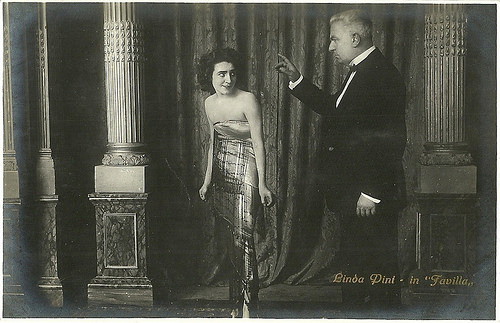
Italian postcard by Ed. G.B. Falci, Milano (Milan), unnumbered. Photo: La Fotominio. Linda Pini in Favilla (Ivo Illuminati, 1921).
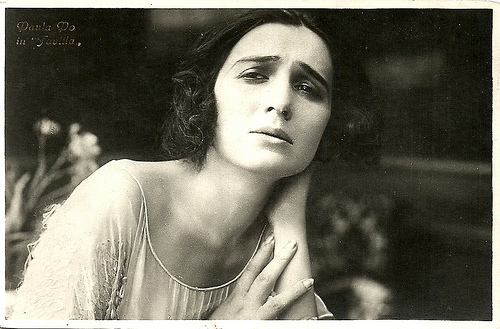
Italian postcard by Ed. G.B. Falci, Milano. Photo: La Fotominio, number unknown. Paola Pô in the Italian silent film Favilla (Ivo Illuminati, 1921).
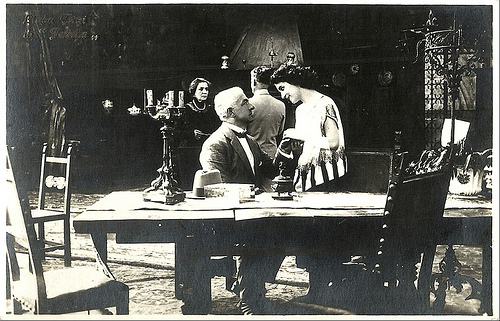
Italian postcard by G.B. Falci, Milano, no. 106. Photo: La Photominio. Linda Pini in Favilla (Ivo Illuminati, 1921).
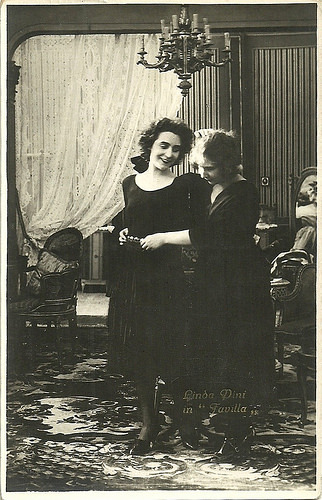
Italian postcard by G.B. Falci, Milano, no. 123. Photo: La Photominio. Linda Pini in Favilla (Ivo Illuminati, 1921).
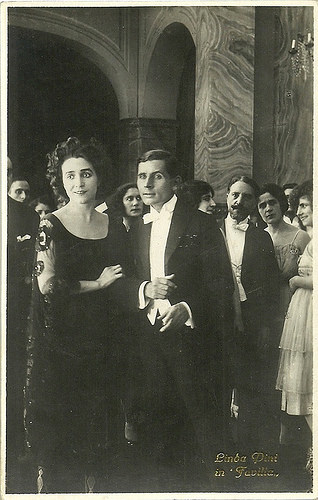
Italian postcard by Ed. G.B. Falci, Milano, no. 182. Photo: La Photominio. Linda Pini in Favilla (Ivo Illuminati, 1921).
Sparkle
In Favilla (Ivo Illuminati, 1921), Linda Pini stars as the title figure, Favilla (lit. Sparkle, Linda Pini ), who, after her father's, death has moved in with her uncle Terenzio. She secretly falls in love with her cousin, the young engineering student Cesare (Carlo Gualendri).
One day, lady d'Etemps (Paola Po) and her cousin Guglielmo visit the house of Favilla's uncle. The lady tries to seduce Cesare, because she loves his money and future inheritance.
For these reasons she also tries to match her own cousin with Favilla. When Favilla unmasks the lady's financial interests, the other unmasks Favilla's love for Cesare.
While the others leave, Cesare and Favilla exchange their first kiss...
At the time, this film of the Roman Medusa-Film company was not so much praised for its story by Guido Clorti as rather for its performances and the cinematography.
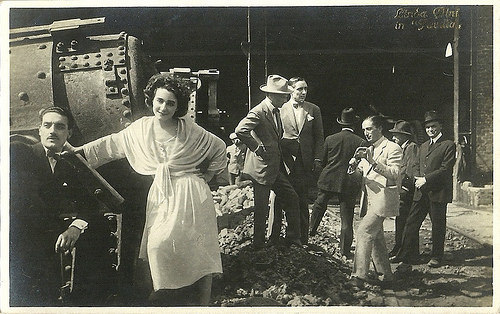
Italian postcard by Ed. G.B. Falci, Milano, no. 231. Photo: La Photominio. Left, Carlo Gualendri and Linda Pini , in Favilla (Ivo Illuminati, 1921).
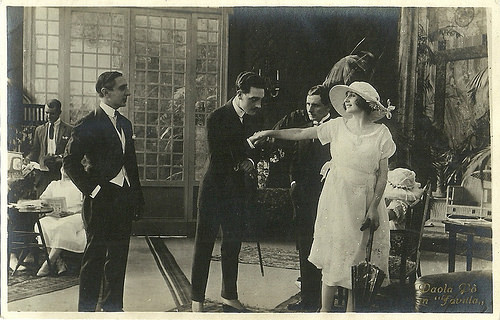
Italian postcard by Ed. G.B. Falci, Milano, no. 219. Photo: La Fotominio. Paola Pô in the Italian silent film Favilla (Ivo Illuminati, 1921). The man in the middle is Carlo Gualendri (Cesare).
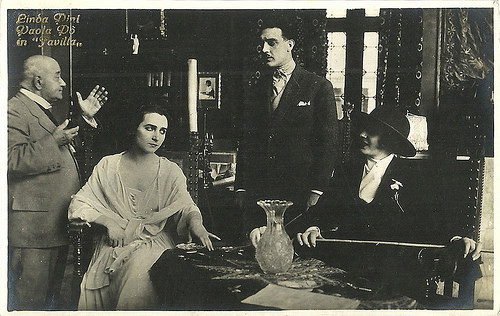
Italian postcard by Ed. G.B. Falci, Milano, no. 122. Photo: La Fotominio. Linda Pini , Carlo Gualendri and Paola Pô in Favilla (Ivo Illuminati, 1921).
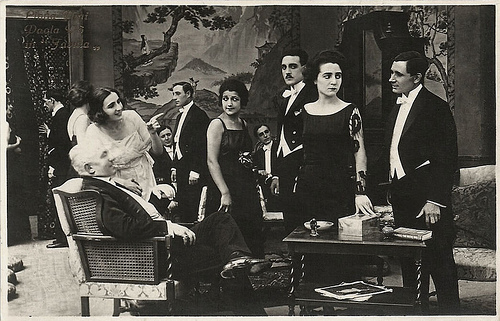
Italian postcard by Ed. G.B. Falci, Milano, no. 121. Photo: La Fotominio. Publicity still for Favilla (Ivo Illuminati, 1921). Favilla looks unsure to Gugliemo, the cousin of lady d'Etemps, while the lady (the woman in white on the left) tries to match them.
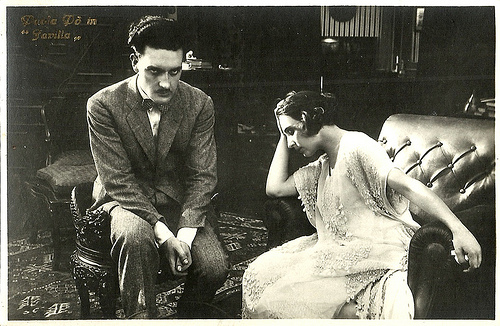
Italian postcard by G.B. Falci, Milano, no. 103. Photo: La Photominio. Carlo Gualendri and Paola Pô in Favilla (Ivo Illuminati, 1921).
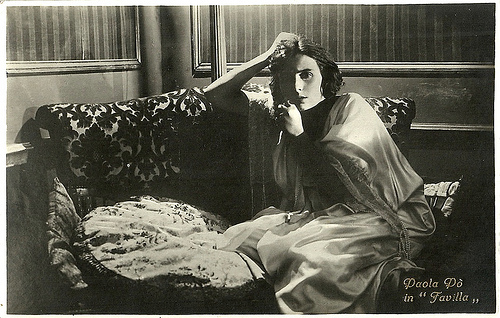
Italian postcard by G.B. Falci, Milano, no. 91. Photo: La Photominio. Paola Pô in Favilla (Ivo Illuminati, 1921).
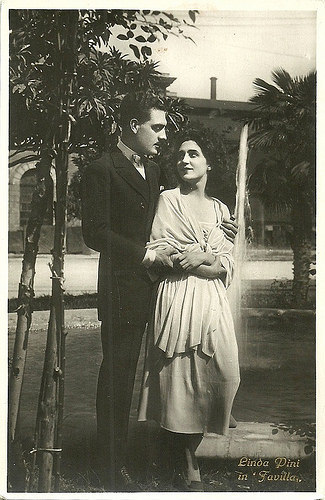
Italian postcard by Ed. G.B. Falci, Milano, unnumbered. Photo: La Fotominio. Linda Pini and Carlo Gualendri in Favilla (Ivo Illuminati, 1921).
Sources: Vittorio Martinelli (Il cinema muto italiano, 1921-1922 - Italian) and IMDb.

Italian postcard by Ed. G.B. Falci, Milano (Milan), unnumbered. Photo: La Fotominio. Linda Pini in Favilla (Ivo Illuminati, 1921).

Italian postcard by Ed. G.B. Falci, Milano. Photo: La Fotominio, number unknown. Paola Pô in the Italian silent film Favilla (Ivo Illuminati, 1921).

Italian postcard by G.B. Falci, Milano, no. 106. Photo: La Photominio. Linda Pini in Favilla (Ivo Illuminati, 1921).

Italian postcard by G.B. Falci, Milano, no. 123. Photo: La Photominio. Linda Pini in Favilla (Ivo Illuminati, 1921).

Italian postcard by Ed. G.B. Falci, Milano, no. 182. Photo: La Photominio. Linda Pini in Favilla (Ivo Illuminati, 1921).
Sparkle
In Favilla (Ivo Illuminati, 1921), Linda Pini stars as the title figure, Favilla (lit. Sparkle, Linda Pini ), who, after her father's, death has moved in with her uncle Terenzio. She secretly falls in love with her cousin, the young engineering student Cesare (Carlo Gualendri).
One day, lady d'Etemps (Paola Po) and her cousin Guglielmo visit the house of Favilla's uncle. The lady tries to seduce Cesare, because she loves his money and future inheritance.
For these reasons she also tries to match her own cousin with Favilla. When Favilla unmasks the lady's financial interests, the other unmasks Favilla's love for Cesare.
While the others leave, Cesare and Favilla exchange their first kiss...
At the time, this film of the Roman Medusa-Film company was not so much praised for its story by Guido Clorti as rather for its performances and the cinematography.

Italian postcard by Ed. G.B. Falci, Milano, no. 231. Photo: La Photominio. Left, Carlo Gualendri and Linda Pini , in Favilla (Ivo Illuminati, 1921).

Italian postcard by Ed. G.B. Falci, Milano, no. 219. Photo: La Fotominio. Paola Pô in the Italian silent film Favilla (Ivo Illuminati, 1921). The man in the middle is Carlo Gualendri (Cesare).

Italian postcard by Ed. G.B. Falci, Milano, no. 122. Photo: La Fotominio. Linda Pini , Carlo Gualendri and Paola Pô in Favilla (Ivo Illuminati, 1921).

Italian postcard by Ed. G.B. Falci, Milano, no. 121. Photo: La Fotominio. Publicity still for Favilla (Ivo Illuminati, 1921). Favilla looks unsure to Gugliemo, the cousin of lady d'Etemps, while the lady (the woman in white on the left) tries to match them.

Italian postcard by G.B. Falci, Milano, no. 103. Photo: La Photominio. Carlo Gualendri and Paola Pô in Favilla (Ivo Illuminati, 1921).

Italian postcard by G.B. Falci, Milano, no. 91. Photo: La Photominio. Paola Pô in Favilla (Ivo Illuminati, 1921).

Italian postcard by Ed. G.B. Falci, Milano, unnumbered. Photo: La Fotominio. Linda Pini and Carlo Gualendri in Favilla (Ivo Illuminati, 1921).
Sources: Vittorio Martinelli (Il cinema muto italiano, 1921-1922 - Italian) and IMDb.
Published on June 13, 2018 22:00
June 12, 2018
André Brulé
Normally Italian divas clutch to the curtains, but here it's André Brulé (1879-1953). This French actor created Arsène Lupin on stage and also played in several films.
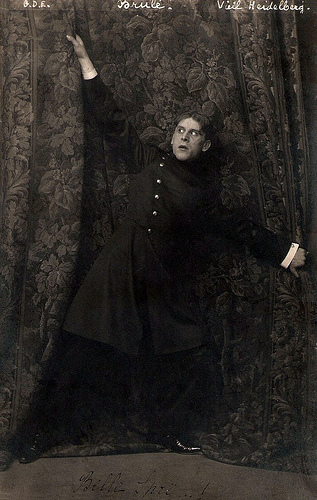
French postcard. It was sent by mail in Brussels, Belgium. Photo: publicity still for the stage play Vieil Heidelberg (Old Heidelberg, 1909).
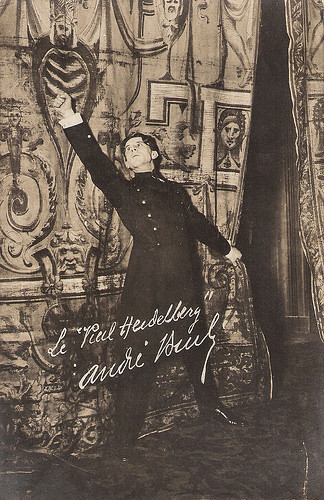
French postcard. Photo: publicity still for the stage play Vieil Heidelberg (Old Heidelberg, 1909).
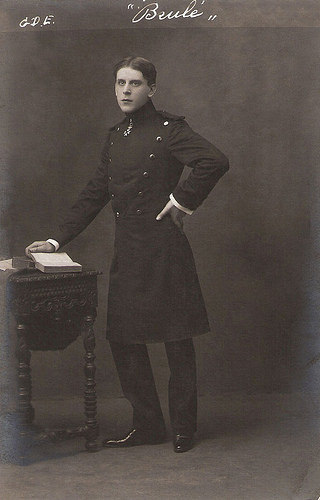
French postcard by G.D.E. Photo: publicity still for the stage play Vieil Heidelberg (Old Heidelberg, 1909).
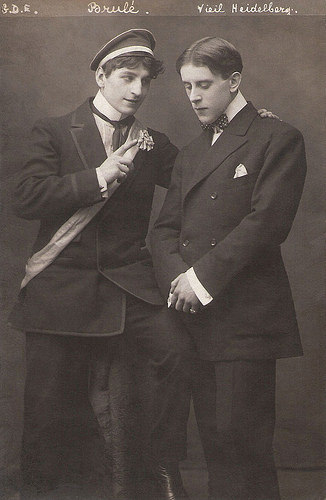
French postcard by G.D.E. Photo: publicity still for the play Vieil Heidelberg (Old Heidelberg, 1909). Sent by mail in Belgium in 1909.
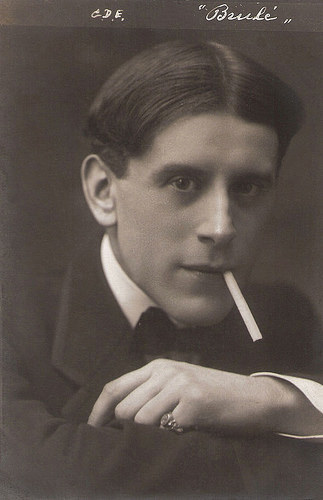
French postcard by G.D.E.
Arsène Lupin
André Brulé was born as André Gresely in Bordeaux, France in 1879.
He was the first actor to impersonate the gentleman thief Arsène Lupin, the hero of the crime fiction novels written by French writer Maurice Leblanc. In Francophone countries, Lupin has enjoyed a popularity as long-lasting and considerable as Sherlock Holmes in the English-speaking world.
Brulé played the double role of Lupin and his alter ego Duc de Charmerace in the stage play Arsène Lupin - Nouvelles Aventures (Arsène Lupin - New Adventures) (1908). The play was written by Francis de Croisset and Maurice Leblanc, and directed by M. Deval. It was staged at the Athenee theatre in Paris, where Brulé had already performed successfully for several years. Opposite Brulé played Escoffier as Inspector Guerchard.
In 1909 Brulé appeared on stage in another great hit: Vieil Heidelberg/Old Heidelberg. This was the French version of Alt Heidelberg, a popular German stage play by Wilhelm Meyer-Förster, staged in France for the first time in 1906, at the Theatre Antoine, in a translation by Maurice Remon & W. Bauer. Later it was staged a.o. at the Odeon Theatre in Paris in the seasons 1906-1907, 1907-1908, 1912-1913 and 1931-1932.
The play knew many adaptations for the cinema. John Emerson directed Old Heidelberg (1915) with Wallace Reid and Lilian Gish . Ernst Lubitsch adapted it as The Student Prince of Old Heidelberg (1927), starring Ramon Novarro and Norma Shearer. In Germany the first of several film adaptations was done by Hans Behrendt in 1923, starring Paul Hartmann and Eva May .
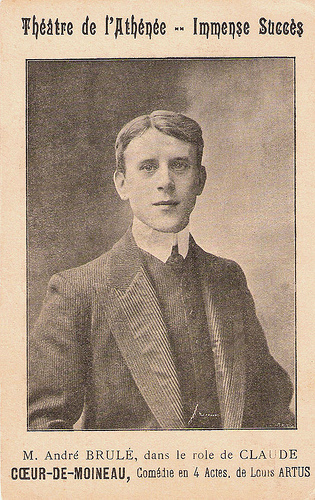
French postcard by Théâtre de l'Athénée, Paris. Photo: publicity still for the boulevard play Coeur de Moineau (Sparrow Heart, 1905) by Louis Artus.
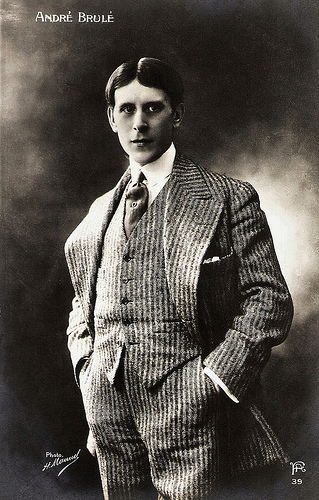
French postcard by FA, no. 39. Photo: Henri Manuel.
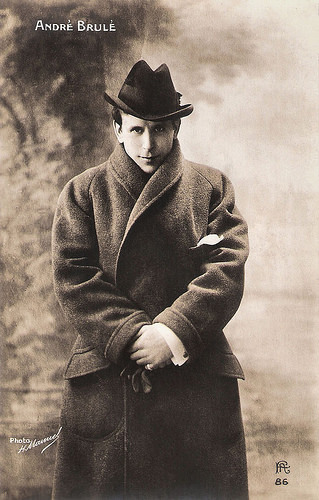
French postcard by FA, no. 86. Photo: Henri Manuel.
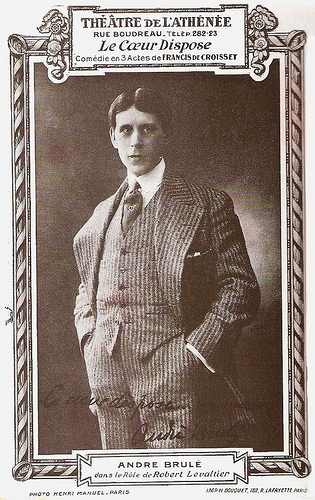
French postcard by Imp. H. Bouquet, Paris for Théâtre de l'Athénée. Photo: Henri Manuel. Publicity still for Le Coeur Disposé (The Arranged Heart, 1912) by Francis de Croisset.
Thief-turned-Cop
André Brulé also appeared in several films. He made his first film appearance as young Werther in the early silent short Werther (Henri Pouctal, 1912), a prestigious Pathé production based on the famous literary novel by Johann Wolfgang Goethe which is considered now as lost.
Other short silent films were Le club des élégants/The Elegant Club (René LePrince, 1912), and Les frères corses/The Corsican brothers (Antoine, 1917) based on the novel by Alexandre Dumas père.
Brulé returned to the screen in the late 1930s. He played such protagonists as the thief-turned-cop François-Eugene Vidocq in Vidocq (Jacques Daroy, 1938), Zoltini in Métropolitain (Maurice Cam, 1939) with Albert Préjean , and Monsieur de Nogrelles in Retour de flamme/The Flame Returns (Henri Fescourt, 1943).
Probably his most interesting film of this period was Les gens du voyage/People Who Travel (Jacques Feyder, 1938) in which he appeared as Fernand opposite Françoise Rosay as a middle-aged lion-tamer.
At Films de France , James Travers reviews: "What is perhaps most striking about Les Gens du voyage is how fresh and modern the film still feels. This is partly due to its daring mix of cinematic styles, reflecting the rapid evolution of cinema in the late 1930's. The liberal use of location filming gives the film a neo-realist feel in places; the plot is a mix of melodrama and policier; and elements of early film noir and poetic realism are also noticeable. Some engaging comic touches provide a pleasing contrast to the films darker moments, without undermining the dramatic content. What is surprising, and what is surely a sign of its director’s genius, is the way in which Feyder manages to combine all these different styles and themes and delivers a work that is cohesive and satisfying."
On stage Brulé appeared among many, many more in L'Épervier (1914) by Francis de Croisset at the Théâtre de l'Ambigu, Le Vertige (1914) by Charles Méré at the Théâtre de Paris, and Les Monstres sacrés (1940) by Jean Cocteau at the Théâtre Michel.
André Brulé died in Paris, in 1953. He was married to French comedy actress Ghislaine Dommanget, but the couple later divorced and she remarried with Louis II, Prince of Monaco.
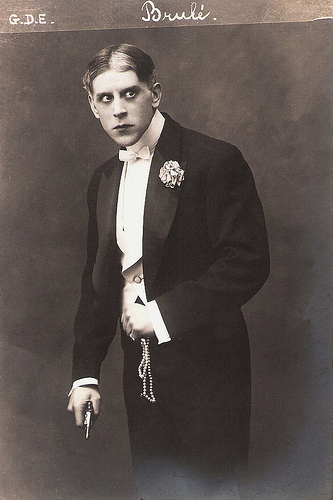
French postcard by G.D.E. Photo: publicity still for the stage play Arsène Lupin - Nouvelles Aventures (Arsène Lupin - New Adventures, 1908).
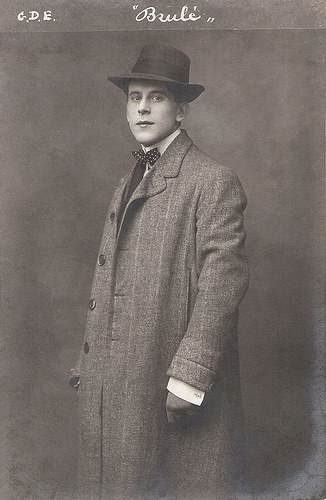
French postcard by G.D.E.
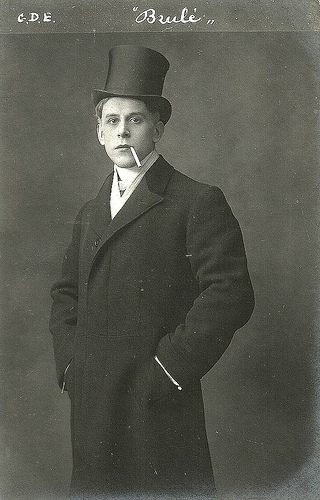
French postcard by G.D.E.
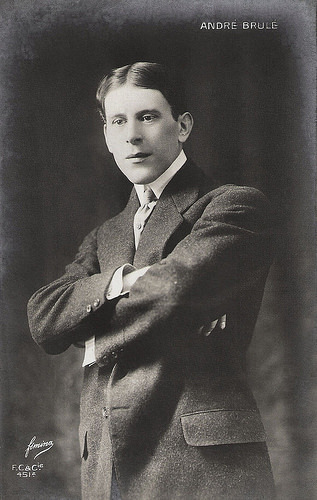
French postcard by F.C. & Cie, no. 451a. Photo: Fémina.
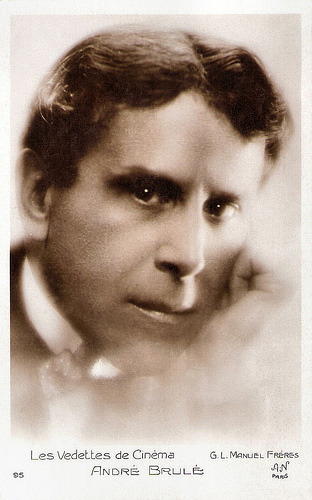
French postcard by A.N., Paris in the Les Vedettes de Cinéma series, no. 95. Photo: G.L. Manuel Frères.
Sources: James Travers (Films de France), Hal Erickson (AllMovie), Wikipedia and .

French postcard. It was sent by mail in Brussels, Belgium. Photo: publicity still for the stage play Vieil Heidelberg (Old Heidelberg, 1909).

French postcard. Photo: publicity still for the stage play Vieil Heidelberg (Old Heidelberg, 1909).

French postcard by G.D.E. Photo: publicity still for the stage play Vieil Heidelberg (Old Heidelberg, 1909).

French postcard by G.D.E. Photo: publicity still for the play Vieil Heidelberg (Old Heidelberg, 1909). Sent by mail in Belgium in 1909.

French postcard by G.D.E.
Arsène Lupin
André Brulé was born as André Gresely in Bordeaux, France in 1879.
He was the first actor to impersonate the gentleman thief Arsène Lupin, the hero of the crime fiction novels written by French writer Maurice Leblanc. In Francophone countries, Lupin has enjoyed a popularity as long-lasting and considerable as Sherlock Holmes in the English-speaking world.
Brulé played the double role of Lupin and his alter ego Duc de Charmerace in the stage play Arsène Lupin - Nouvelles Aventures (Arsène Lupin - New Adventures) (1908). The play was written by Francis de Croisset and Maurice Leblanc, and directed by M. Deval. It was staged at the Athenee theatre in Paris, where Brulé had already performed successfully for several years. Opposite Brulé played Escoffier as Inspector Guerchard.
In 1909 Brulé appeared on stage in another great hit: Vieil Heidelberg/Old Heidelberg. This was the French version of Alt Heidelberg, a popular German stage play by Wilhelm Meyer-Förster, staged in France for the first time in 1906, at the Theatre Antoine, in a translation by Maurice Remon & W. Bauer. Later it was staged a.o. at the Odeon Theatre in Paris in the seasons 1906-1907, 1907-1908, 1912-1913 and 1931-1932.
The play knew many adaptations for the cinema. John Emerson directed Old Heidelberg (1915) with Wallace Reid and Lilian Gish . Ernst Lubitsch adapted it as The Student Prince of Old Heidelberg (1927), starring Ramon Novarro and Norma Shearer. In Germany the first of several film adaptations was done by Hans Behrendt in 1923, starring Paul Hartmann and Eva May .

French postcard by Théâtre de l'Athénée, Paris. Photo: publicity still for the boulevard play Coeur de Moineau (Sparrow Heart, 1905) by Louis Artus.

French postcard by FA, no. 39. Photo: Henri Manuel.

French postcard by FA, no. 86. Photo: Henri Manuel.

French postcard by Imp. H. Bouquet, Paris for Théâtre de l'Athénée. Photo: Henri Manuel. Publicity still for Le Coeur Disposé (The Arranged Heart, 1912) by Francis de Croisset.
Thief-turned-Cop
André Brulé also appeared in several films. He made his first film appearance as young Werther in the early silent short Werther (Henri Pouctal, 1912), a prestigious Pathé production based on the famous literary novel by Johann Wolfgang Goethe which is considered now as lost.
Other short silent films were Le club des élégants/The Elegant Club (René LePrince, 1912), and Les frères corses/The Corsican brothers (Antoine, 1917) based on the novel by Alexandre Dumas père.
Brulé returned to the screen in the late 1930s. He played such protagonists as the thief-turned-cop François-Eugene Vidocq in Vidocq (Jacques Daroy, 1938), Zoltini in Métropolitain (Maurice Cam, 1939) with Albert Préjean , and Monsieur de Nogrelles in Retour de flamme/The Flame Returns (Henri Fescourt, 1943).
Probably his most interesting film of this period was Les gens du voyage/People Who Travel (Jacques Feyder, 1938) in which he appeared as Fernand opposite Françoise Rosay as a middle-aged lion-tamer.
At Films de France , James Travers reviews: "What is perhaps most striking about Les Gens du voyage is how fresh and modern the film still feels. This is partly due to its daring mix of cinematic styles, reflecting the rapid evolution of cinema in the late 1930's. The liberal use of location filming gives the film a neo-realist feel in places; the plot is a mix of melodrama and policier; and elements of early film noir and poetic realism are also noticeable. Some engaging comic touches provide a pleasing contrast to the films darker moments, without undermining the dramatic content. What is surprising, and what is surely a sign of its director’s genius, is the way in which Feyder manages to combine all these different styles and themes and delivers a work that is cohesive and satisfying."
On stage Brulé appeared among many, many more in L'Épervier (1914) by Francis de Croisset at the Théâtre de l'Ambigu, Le Vertige (1914) by Charles Méré at the Théâtre de Paris, and Les Monstres sacrés (1940) by Jean Cocteau at the Théâtre Michel.
André Brulé died in Paris, in 1953. He was married to French comedy actress Ghislaine Dommanget, but the couple later divorced and she remarried with Louis II, Prince of Monaco.

French postcard by G.D.E. Photo: publicity still for the stage play Arsène Lupin - Nouvelles Aventures (Arsène Lupin - New Adventures, 1908).

French postcard by G.D.E.

French postcard by G.D.E.

French postcard by F.C. & Cie, no. 451a. Photo: Fémina.

French postcard by A.N., Paris in the Les Vedettes de Cinéma series, no. 95. Photo: G.L. Manuel Frères.
Sources: James Travers (Films de France), Hal Erickson (AllMovie), Wikipedia and .
Published on June 12, 2018 22:00
June 11, 2018
Charlotte Susa
Blond, German actress Charlotte Susa (1898-1967), was a major operetta star of the German-speaking world, and also a popular femme fatale of the German silent and early sound film.

Austrian postcard by Iris Verlag, no. 5843. Photo: Verleih Ifuk Film / Delog Film. Charlotte Susa in Zapfenstreich am Rhein/Tattoo on the Rhine (Jaap Speyer, 1930).

Austrian postcard by Iris Verlag, no. 5844. Photo: Verleih Ifuk Film / Delog Film. Charlotte Susa in Zapfenstreich am Rhein/Tattoo on the Rhine (Jaap Speyer, 1930).

French postcard by Ross, no. 5122/1. Photo: Ufa.
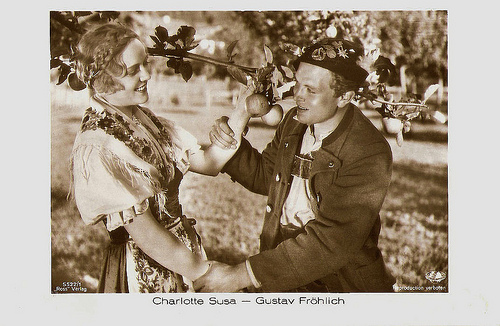
German postcard by Ross Verlag, no. 5522/1, 1930-1931. Photo: Deutsche Universal Film. Publicity Still for Zwei Menschen/Two People (Erich Waschneck, 1930) with Gustav Fröhlich .
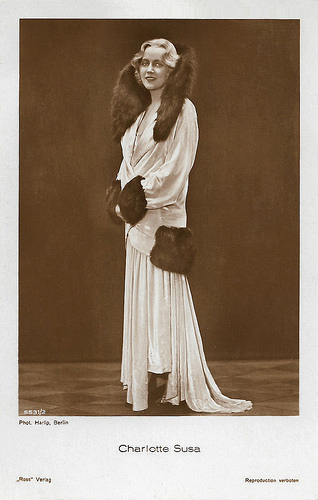
German postcard by Ross Verlag, no. 5531/2, 1930-1931. Photo: Harlip, Berlin.
Superior Singer
Charlotte Susa (sometimes written as Suza) was born Charlotta Wegmüller near Memel, Germany (now Klaipeda, Lithuania).
In 1915, she first appeared at a stage in Tilsit. She chose her mothers maiden name, Susa, as her stage name and began a successful career as a singer and actress at different German Opera and Operetta stages.
She was as well a superior singer as a competent dramatic actress. In 1926, director Richard Eichberg spotted her for the cinema. Susa made her film debut in the German silent film Der Prinz und die Tänzerin/The Prince and the Dancer (Richard Eichberg, 1926) opposite Hans Albers .
More silent films followed like Arme kleine Colombine/Poor Little Columbine (Franz Seitz, 1927), Die Pflicht zu schweigen/The Obligation to Remain Silent (Carl Wilhelm, 1928), and Du sollst nicht stehlen/Thou Art Not Steal (Victor Janson, 1928).
Susa became famous for her roles as a femme fatale in films like Sünde und Moral/Sin and Morals (Erich Kober, 1929), and Erotikon/Seduction (Gustav Machatý, 1929).
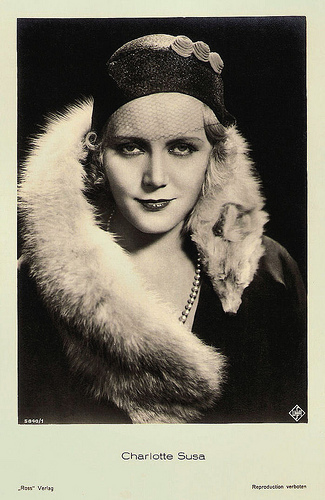
German postcard by Ross Verlag, no. 5840/1, 1930-1931. Photo: Ufa.
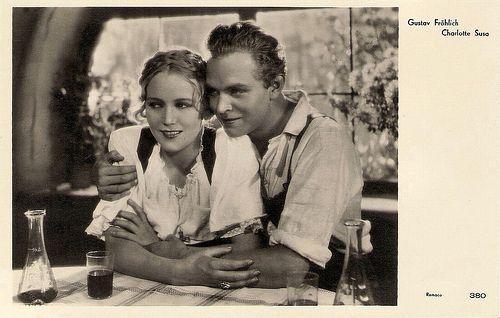
Dutch postcard by JosPe, Arnhem, no. 380, with Gustav Fröhlich in Zwei Menschen/Two People (Erich Waschneck, 1930). Photo: Remaco.
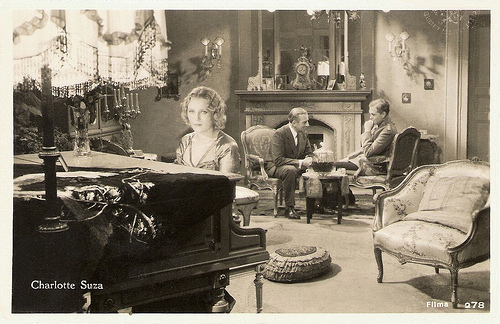
Dutch postcard by Filma, no. 278. Photo: still from Photo: still from Unter falscher Flagge/Under False Flagg (Johannes Meyer, 1932). In the background sits Gustav Fröhlich .
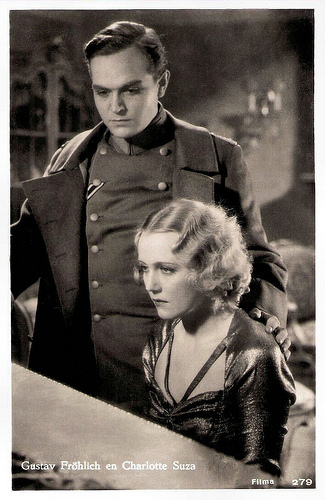
Dutch postcard by JosPe, no. 279. Photo: Filma. Publicity still for Unter falscher Flagge/Under False Flagg (Johannes Meyer, 1932) with, again, Gustav Fröhlich .
Lighthearted Femme Fatales
With her trained voice Charlotte Susa didn't have any difficulties to make the transition to the sound era in films like Der Tiger/The Tiger Murder Case (Johannes Meyer, 1930)), Zwei Menschen/Two Humans (Erich Waschneck, 1930), and Der Greifer/The Snatcher (Richard Eichberg, 1930).
She had again great successes with Die Pranke/The Paw (Hans Steinhoff, 1931), and Unter falscher Flagge/Under False Colours (Johannes Meyer, 1932).
Susa played mostly lighthearted femme fatales and was popular enough for MGM to offer her a contract in 1932. She remained in Hollywood until 1934 but failed to appear in a single feature film.
Back in Germany she made films like Henker, Frauen und Soldaten/Hangmen, Women and Soldiers (Johannes Meyer, 1935), and Wasser für Canitoga/Water for Canitoga (Herbert Selpin, 1939) at Hans Albers ' side.
Hans J. Wollstein at AllMovie: "Her return to Germany was highly anticipated but she ran afoul of Joseph Goebbels, the infamous Nazi minister of propaganda, and was banned from screen work in 1941."
Her last film part was a minor role in the comedy Der Gasmann/The Gas Meter Reader (Carl Froelich, 1941) starring Heinz Rühmann and Anny Ondra . This film was her last work for the screen.
Charlotte Susa was married to Paul Cablin, Fritz Malkowsky, and from 1939 on to actor Andrews Engelmann. After the war she acted again for the theatre, often at Engelmann's side. Charlotte Susa died in Basel, Switzerland, aged 78.
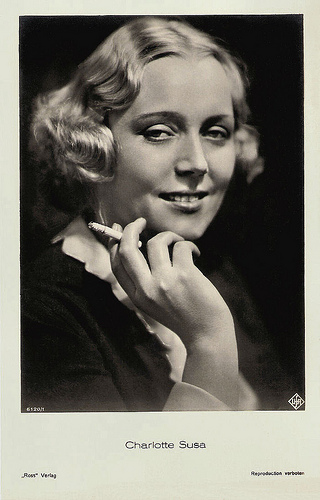
German postcard by Ross Verlag, no. 6120/1, 1931-1932. Photo: Ufa.
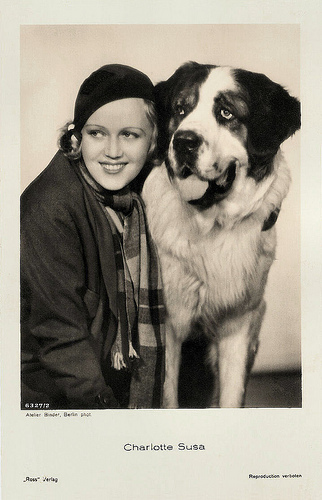
German postcard by Ross Verlag, no. 6327/2, 1931-1932. Photo: Atelier Binder, Berlin.
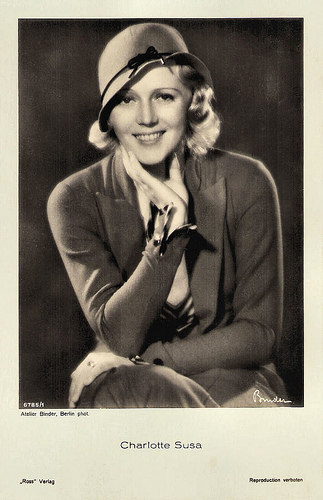
German postcard by Ross Verlag, no. 6785/1, 1931-1932. Photo: Alex Binder, Berlin.
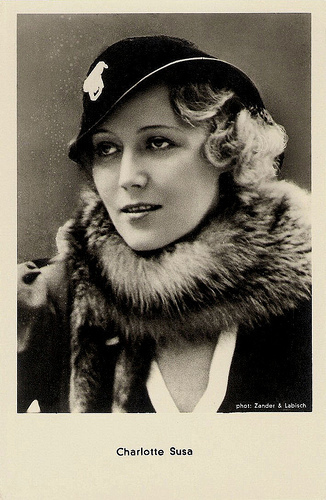
Austrian postcard by Iris, no. 6659. Photo: Zander & Labisch.
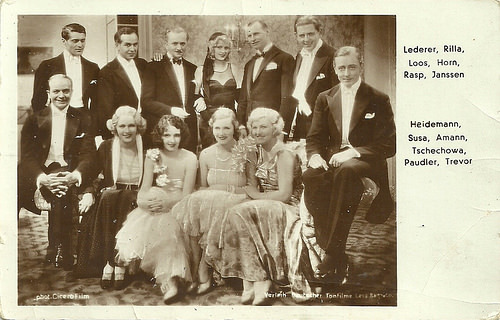
German postcard. Photo: Cicero Film / Distribution Deutsche Tonfilme. The 'fine fleur' of late silent German cinema stars, united for a photo for an early sound film company. Standing left to right: Francis/Franz Lederer, Walter Rilla , Theodor Loos , Camilla Horn , Fritz Rasp and Walter Janssen. Sitting left to right: Paul Heidemann , Charlotte Susa, Betty Amann , Olga Tschechowa , Maria Paudler and Jack Trevor . It was a publicity still for the early sound comedy Die grosse Sehnsucht/The Great Longing (Stefan Szekely/Steve Sekely, 1930), in which all acted, mostly as themselves - only Loos and Horn played characters. The plot was an excuse for 35 stars to debut in a talking picture.
Sources: Thomas Staedeli (Cyranos), Hans J. Wollstein (AllMovie), Wikipedia, and .

Austrian postcard by Iris Verlag, no. 5843. Photo: Verleih Ifuk Film / Delog Film. Charlotte Susa in Zapfenstreich am Rhein/Tattoo on the Rhine (Jaap Speyer, 1930).

Austrian postcard by Iris Verlag, no. 5844. Photo: Verleih Ifuk Film / Delog Film. Charlotte Susa in Zapfenstreich am Rhein/Tattoo on the Rhine (Jaap Speyer, 1930).

French postcard by Ross, no. 5122/1. Photo: Ufa.

German postcard by Ross Verlag, no. 5522/1, 1930-1931. Photo: Deutsche Universal Film. Publicity Still for Zwei Menschen/Two People (Erich Waschneck, 1930) with Gustav Fröhlich .

German postcard by Ross Verlag, no. 5531/2, 1930-1931. Photo: Harlip, Berlin.
Superior Singer
Charlotte Susa (sometimes written as Suza) was born Charlotta Wegmüller near Memel, Germany (now Klaipeda, Lithuania).
In 1915, she first appeared at a stage in Tilsit. She chose her mothers maiden name, Susa, as her stage name and began a successful career as a singer and actress at different German Opera and Operetta stages.
She was as well a superior singer as a competent dramatic actress. In 1926, director Richard Eichberg spotted her for the cinema. Susa made her film debut in the German silent film Der Prinz und die Tänzerin/The Prince and the Dancer (Richard Eichberg, 1926) opposite Hans Albers .
More silent films followed like Arme kleine Colombine/Poor Little Columbine (Franz Seitz, 1927), Die Pflicht zu schweigen/The Obligation to Remain Silent (Carl Wilhelm, 1928), and Du sollst nicht stehlen/Thou Art Not Steal (Victor Janson, 1928).
Susa became famous for her roles as a femme fatale in films like Sünde und Moral/Sin and Morals (Erich Kober, 1929), and Erotikon/Seduction (Gustav Machatý, 1929).

German postcard by Ross Verlag, no. 5840/1, 1930-1931. Photo: Ufa.

Dutch postcard by JosPe, Arnhem, no. 380, with Gustav Fröhlich in Zwei Menschen/Two People (Erich Waschneck, 1930). Photo: Remaco.

Dutch postcard by Filma, no. 278. Photo: still from Photo: still from Unter falscher Flagge/Under False Flagg (Johannes Meyer, 1932). In the background sits Gustav Fröhlich .

Dutch postcard by JosPe, no. 279. Photo: Filma. Publicity still for Unter falscher Flagge/Under False Flagg (Johannes Meyer, 1932) with, again, Gustav Fröhlich .
Lighthearted Femme Fatales
With her trained voice Charlotte Susa didn't have any difficulties to make the transition to the sound era in films like Der Tiger/The Tiger Murder Case (Johannes Meyer, 1930)), Zwei Menschen/Two Humans (Erich Waschneck, 1930), and Der Greifer/The Snatcher (Richard Eichberg, 1930).
She had again great successes with Die Pranke/The Paw (Hans Steinhoff, 1931), and Unter falscher Flagge/Under False Colours (Johannes Meyer, 1932).
Susa played mostly lighthearted femme fatales and was popular enough for MGM to offer her a contract in 1932. She remained in Hollywood until 1934 but failed to appear in a single feature film.
Back in Germany she made films like Henker, Frauen und Soldaten/Hangmen, Women and Soldiers (Johannes Meyer, 1935), and Wasser für Canitoga/Water for Canitoga (Herbert Selpin, 1939) at Hans Albers ' side.
Hans J. Wollstein at AllMovie: "Her return to Germany was highly anticipated but she ran afoul of Joseph Goebbels, the infamous Nazi minister of propaganda, and was banned from screen work in 1941."
Her last film part was a minor role in the comedy Der Gasmann/The Gas Meter Reader (Carl Froelich, 1941) starring Heinz Rühmann and Anny Ondra . This film was her last work for the screen.
Charlotte Susa was married to Paul Cablin, Fritz Malkowsky, and from 1939 on to actor Andrews Engelmann. After the war she acted again for the theatre, often at Engelmann's side. Charlotte Susa died in Basel, Switzerland, aged 78.

German postcard by Ross Verlag, no. 6120/1, 1931-1932. Photo: Ufa.

German postcard by Ross Verlag, no. 6327/2, 1931-1932. Photo: Atelier Binder, Berlin.

German postcard by Ross Verlag, no. 6785/1, 1931-1932. Photo: Alex Binder, Berlin.

Austrian postcard by Iris, no. 6659. Photo: Zander & Labisch.

German postcard. Photo: Cicero Film / Distribution Deutsche Tonfilme. The 'fine fleur' of late silent German cinema stars, united for a photo for an early sound film company. Standing left to right: Francis/Franz Lederer, Walter Rilla , Theodor Loos , Camilla Horn , Fritz Rasp and Walter Janssen. Sitting left to right: Paul Heidemann , Charlotte Susa, Betty Amann , Olga Tschechowa , Maria Paudler and Jack Trevor . It was a publicity still for the early sound comedy Die grosse Sehnsucht/The Great Longing (Stefan Szekely/Steve Sekely, 1930), in which all acted, mostly as themselves - only Loos and Horn played characters. The plot was an excuse for 35 stars to debut in a talking picture.
Sources: Thomas Staedeli (Cyranos), Hans J. Wollstein (AllMovie), Wikipedia, and .
Published on June 11, 2018 22:00
June 10, 2018
Danièle Gaubert
French actress Danièle Gaubert (1943–1987) made a sensational debut as a sexy adolescent seductress in Claude Autant-Lara’s Les régates de San Francisco/The Regattas of San Francisco (1960). She continued to play sexy and rebellious roles in several international films of the 1960s, including the first modern adult film Camille 2000 (1969). In the early 1970s, she retired after marrying Olympic ski champion Jean-Claude Killy.
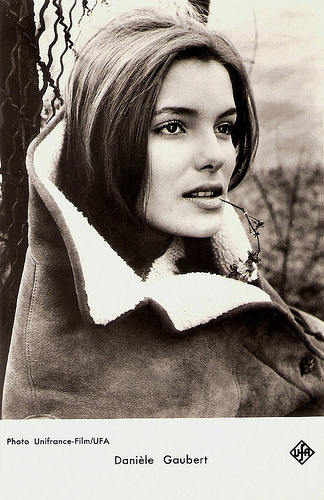
French postcard by Editions P.I., Paris (French licency holder for UFA). Photo: Unifrance-Film / UFA.
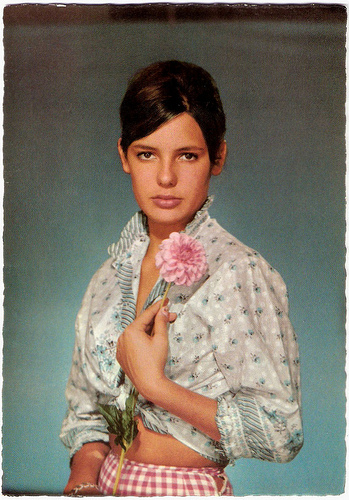
French postcard by E.D.U.G., Paris, no. 159. Photo: Sam Lévin.
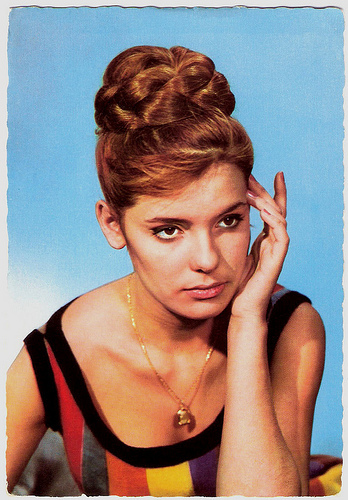
French postcard by E.D.U.G., Paris, no. 161. Photo: Sam Lévin.
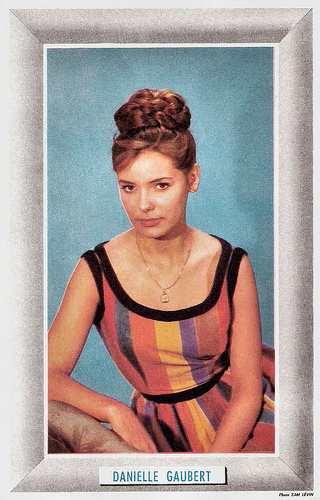
French collectors card by Ste. Anne, Marseille. Photo: Sam Lévin.
Sexy Adolescent
Danièle Louise Régina Gaubert was born in Nuar, France in 1943.
As an adolescent she made her film debut in Les régates de San Francisco/The Regattas of San Francisco (Claude Autant-Lara, 1960). She played a sexy 15-year old girl who seduces handsome dockworker Laurent Terzieff .
Raoul Lévy, the producer of the film, cut several scenes without the authorisation of Claude Autant-Lara, who subsequently had his name withdrawn from the credits. When the film was shown in France, there were several incidents in cinemas. The film was banned by the mayors of Toulouse and Nancy, and was originally also banned for export.
Next Gaubert starred as a rebellious teenager in a French suburb in Terrain vague/Wasteland (1960), directed by old master Marcel Carné on his retour. That year she appeared topless on the cover of Esquire magazine.
She reunited with Claude Autant-Lara for the costume comedy Vive Henri IV... vive l'amour!/Long Live Henry IV... Long Live Love (1961), in which she was the beautiful girl between 17th-century king Henri IV (Francis Claude) and a disinterested son ( Jean Sorel ).
She appeared in Italy in Una storia milanese/A Milanese Story (Eriprando Visconti, 1962) with Romolo Valli, and in the German production Der Zigeunerbaron/The Gypsy baron (Kurt Wilhelm, 1962) starring Carlos Thompson . She also appeared in the American-Japanese rescue drama Flight from Ashiya (Michael Anderson, 1964) starring Yul Brynner .
Most of these films turned out to be mediocre. That year she married Rhadamés Leonidas Trujillo, son of Rafael Trujillo, the assassinated dictator of the Dominican Republic. Rhadamés Leonidas Trujillo was imprisoned in Rouen, on charges brought by his six half-brothers and half-sisters searching for the lost Trujillo fortune. Gaubert gave birth to their daughter Maria Danielle in 1965, and to their son Leonidas Rhadames in 1966.
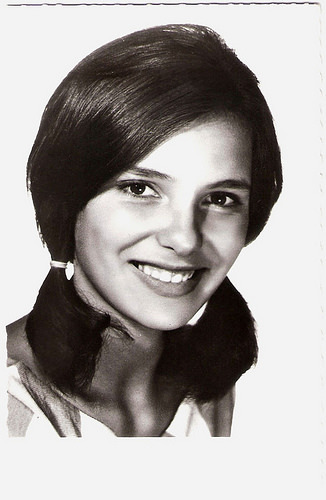
French postcard by Editions P.I., no. 1052. Photo: Sam Lévin.
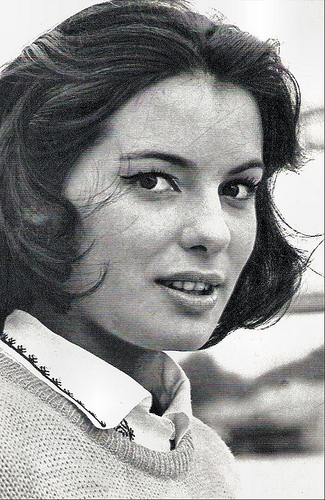
Romanian postcard by Casa Filmului Acin, no. 124.
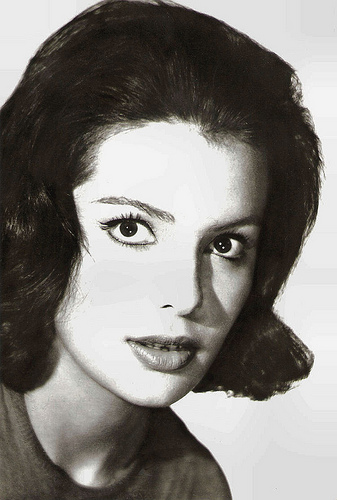
Romanian postcard by Casa Filmului Acin, no. 125.
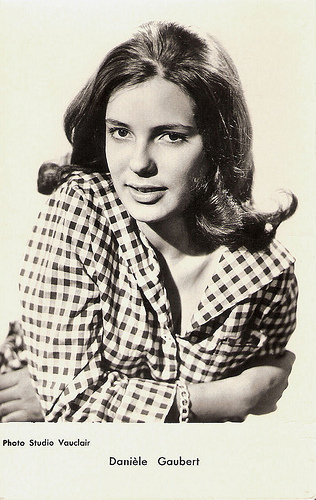
French postcard by Editions P.I., Paris, no. 1096. Offered by Les carbones Korès 'Carboplane'. Photo: Studio Vauclair.
Trendsetting, Forward-looking Pictures
After her divorce of Trujillo in 1967, Danièle Gaubert continued to play leading roles in international films. In the French-German drama Le grand dadais/The Big Softie (Pierre Granier-Deferre, 1967), she appeared opposite Jacques Perrin and Eva Renzi. In La louve solitaire/Claws of the Cat (Edouard Logereau, 1968) she starred as a sexy jewel thief opposite Michel Duchaussoy.
Gaubert then starred in Camille 2000/Forbidden Love (Radley Metzger, 1969), an erotic version of Alexandre Dumas famous story of courtesan Marguerite Gauthier’s love for Armand Duval (Nino Castelnuovo). It was one of the trendsetting, forward-looking pictures that marked the end of the 1960s, and can be seen as the first of the modern, adult films.
In Italy, she appeared with Horst Buchholz in Come, quando, perché/How, When and with Whom (Antonio Pietrangeli, Valerio Zurlini, 1969). Director Antonio Pietrangeli tragically drowned while shooting the last scenes of the film in Gaeta, Italy.
Back in France, Gaubert starred in the psychedelic comedy Paris n'existe pas/Paris Does Not Exist (Robert Benayoun, 1969) with Serge Gainsbourg . Then she appeared in the C-grade war thriller Underground (Arthur H. Nadel, 1970) starring Robert Goulet.
During the 1970s she only made one last film, the Warner Brothers production Snow Job (George Englund, 1972). The film featured ski champion Jean-Claude Killy as a downhill ski instructor who plans a heist up in the mountains in Italy.
Gaubert and Killy had met in 1968 and they married in 1973. During the late 1960’s she had posed nude for magazines like Playboy and the Italian Playmen. In 1974 she and Killy posed nude together for Oui magazine. Together they had a daughter, Emilie.
Danièle Gaubert died of cancer in 1987 in Marseille, only 44.
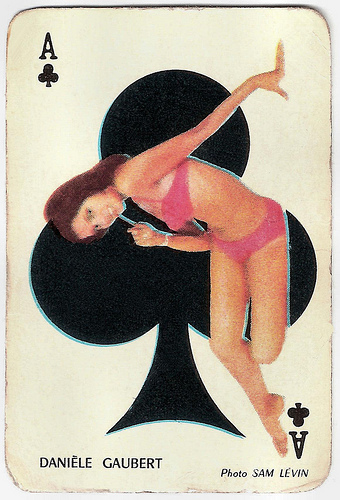
Small French playing card. Photo: Sam Lévin.
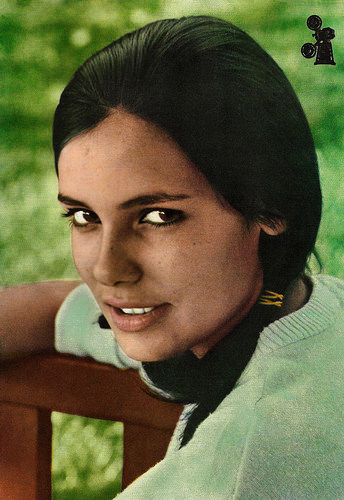
Spanish postcard by Postalcolor, Hospitalet (Barcelona), no. 129. Photo: Unifrance.
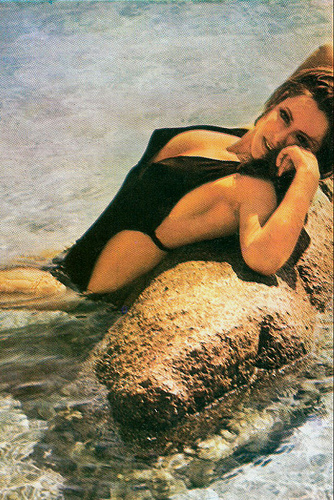
Yugoslavian postcard by Cik Razglednica.
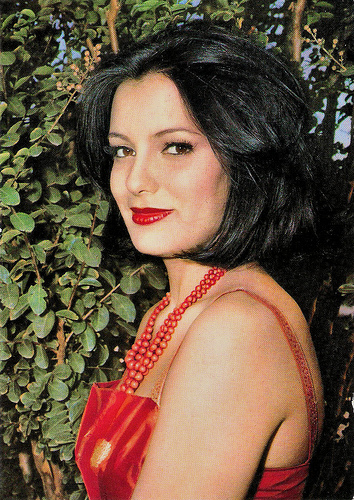
French postcard by Editions P.I., Paris, offered by Les Carbones Korès 'Carboplane', no. 1106. Photo: Anders.
Trailer Camille 2000 (1969). Source: Tenzis (YouTube).
Sources: Glamour Girls of the Silver Screen, Wikipedia (French) and .

French postcard by Editions P.I., Paris (French licency holder for UFA). Photo: Unifrance-Film / UFA.

French postcard by E.D.U.G., Paris, no. 159. Photo: Sam Lévin.

French postcard by E.D.U.G., Paris, no. 161. Photo: Sam Lévin.

French collectors card by Ste. Anne, Marseille. Photo: Sam Lévin.
Sexy Adolescent
Danièle Louise Régina Gaubert was born in Nuar, France in 1943.
As an adolescent she made her film debut in Les régates de San Francisco/The Regattas of San Francisco (Claude Autant-Lara, 1960). She played a sexy 15-year old girl who seduces handsome dockworker Laurent Terzieff .
Raoul Lévy, the producer of the film, cut several scenes without the authorisation of Claude Autant-Lara, who subsequently had his name withdrawn from the credits. When the film was shown in France, there were several incidents in cinemas. The film was banned by the mayors of Toulouse and Nancy, and was originally also banned for export.
Next Gaubert starred as a rebellious teenager in a French suburb in Terrain vague/Wasteland (1960), directed by old master Marcel Carné on his retour. That year she appeared topless on the cover of Esquire magazine.
She reunited with Claude Autant-Lara for the costume comedy Vive Henri IV... vive l'amour!/Long Live Henry IV... Long Live Love (1961), in which she was the beautiful girl between 17th-century king Henri IV (Francis Claude) and a disinterested son ( Jean Sorel ).
She appeared in Italy in Una storia milanese/A Milanese Story (Eriprando Visconti, 1962) with Romolo Valli, and in the German production Der Zigeunerbaron/The Gypsy baron (Kurt Wilhelm, 1962) starring Carlos Thompson . She also appeared in the American-Japanese rescue drama Flight from Ashiya (Michael Anderson, 1964) starring Yul Brynner .
Most of these films turned out to be mediocre. That year she married Rhadamés Leonidas Trujillo, son of Rafael Trujillo, the assassinated dictator of the Dominican Republic. Rhadamés Leonidas Trujillo was imprisoned in Rouen, on charges brought by his six half-brothers and half-sisters searching for the lost Trujillo fortune. Gaubert gave birth to their daughter Maria Danielle in 1965, and to their son Leonidas Rhadames in 1966.

French postcard by Editions P.I., no. 1052. Photo: Sam Lévin.

Romanian postcard by Casa Filmului Acin, no. 124.

Romanian postcard by Casa Filmului Acin, no. 125.

French postcard by Editions P.I., Paris, no. 1096. Offered by Les carbones Korès 'Carboplane'. Photo: Studio Vauclair.
Trendsetting, Forward-looking Pictures
After her divorce of Trujillo in 1967, Danièle Gaubert continued to play leading roles in international films. In the French-German drama Le grand dadais/The Big Softie (Pierre Granier-Deferre, 1967), she appeared opposite Jacques Perrin and Eva Renzi. In La louve solitaire/Claws of the Cat (Edouard Logereau, 1968) she starred as a sexy jewel thief opposite Michel Duchaussoy.
Gaubert then starred in Camille 2000/Forbidden Love (Radley Metzger, 1969), an erotic version of Alexandre Dumas famous story of courtesan Marguerite Gauthier’s love for Armand Duval (Nino Castelnuovo). It was one of the trendsetting, forward-looking pictures that marked the end of the 1960s, and can be seen as the first of the modern, adult films.
In Italy, she appeared with Horst Buchholz in Come, quando, perché/How, When and with Whom (Antonio Pietrangeli, Valerio Zurlini, 1969). Director Antonio Pietrangeli tragically drowned while shooting the last scenes of the film in Gaeta, Italy.
Back in France, Gaubert starred in the psychedelic comedy Paris n'existe pas/Paris Does Not Exist (Robert Benayoun, 1969) with Serge Gainsbourg . Then she appeared in the C-grade war thriller Underground (Arthur H. Nadel, 1970) starring Robert Goulet.
During the 1970s she only made one last film, the Warner Brothers production Snow Job (George Englund, 1972). The film featured ski champion Jean-Claude Killy as a downhill ski instructor who plans a heist up in the mountains in Italy.
Gaubert and Killy had met in 1968 and they married in 1973. During the late 1960’s she had posed nude for magazines like Playboy and the Italian Playmen. In 1974 she and Killy posed nude together for Oui magazine. Together they had a daughter, Emilie.
Danièle Gaubert died of cancer in 1987 in Marseille, only 44.

Small French playing card. Photo: Sam Lévin.

Spanish postcard by Postalcolor, Hospitalet (Barcelona), no. 129. Photo: Unifrance.

Yugoslavian postcard by Cik Razglednica.

French postcard by Editions P.I., Paris, offered by Les Carbones Korès 'Carboplane', no. 1106. Photo: Anders.
Trailer Camille 2000 (1969). Source: Tenzis (YouTube).
Sources: Glamour Girls of the Silver Screen, Wikipedia (French) and .
Published on June 10, 2018 22:00
Paul van Yperen's Blog
- Paul van Yperen's profile
- 13 followers
Paul van Yperen isn't a Goodreads Author
(yet),
but they
do have a blog,
so here are some recent posts imported from
their feed.



